Implement and Monitor Care Answer 2022
VerifiedAdded on 2022/10/17
|26
|4927
|9
AI Summary
Contribute Materials
Your contribution can guide someone’s learning journey. Share your
documents today.
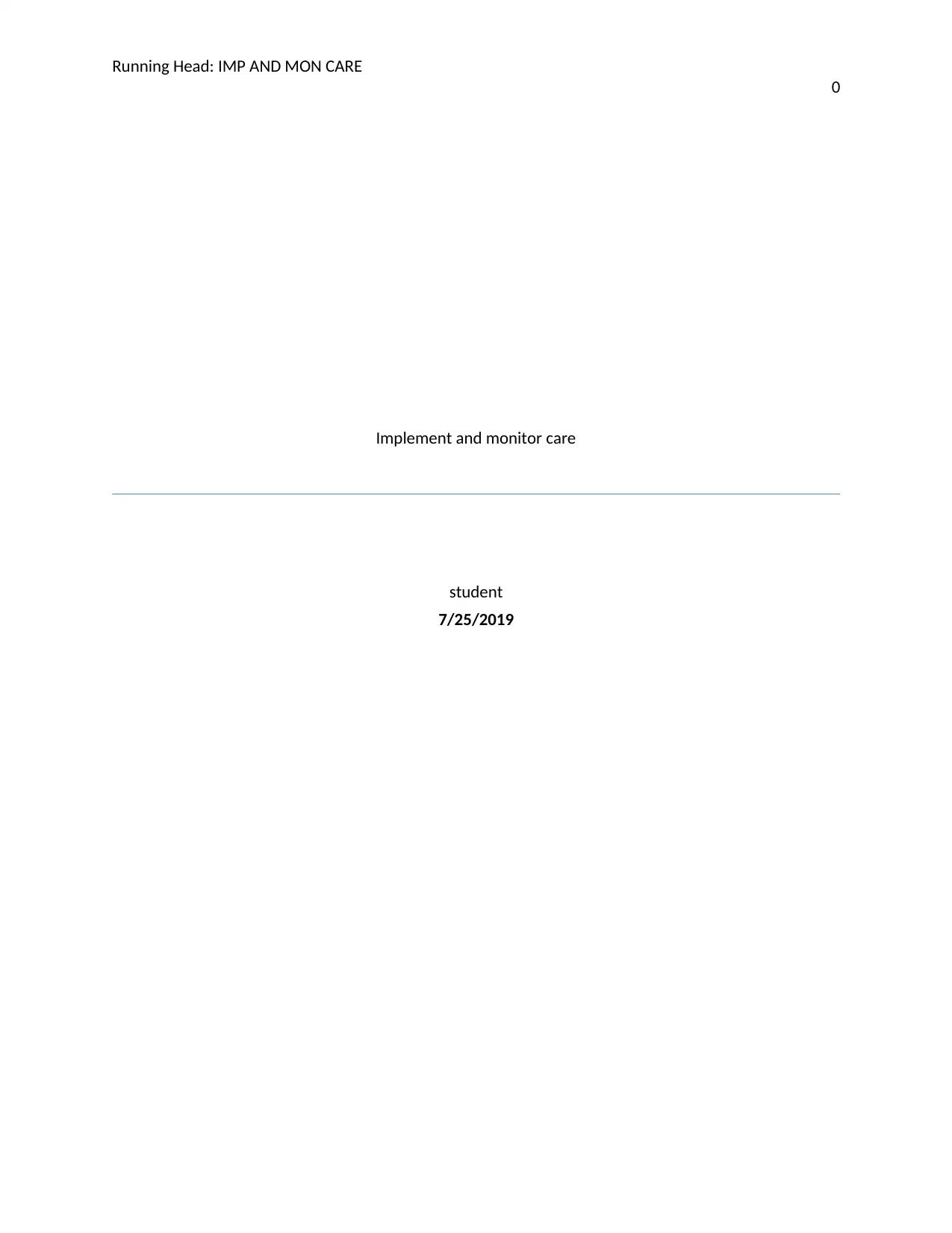
Running Head: IMP AND MON CARE
0
Implement and monitor care
student
7/25/2019
0
Implement and monitor care
student
7/25/2019
Secure Best Marks with AI Grader
Need help grading? Try our AI Grader for instant feedback on your assignments.
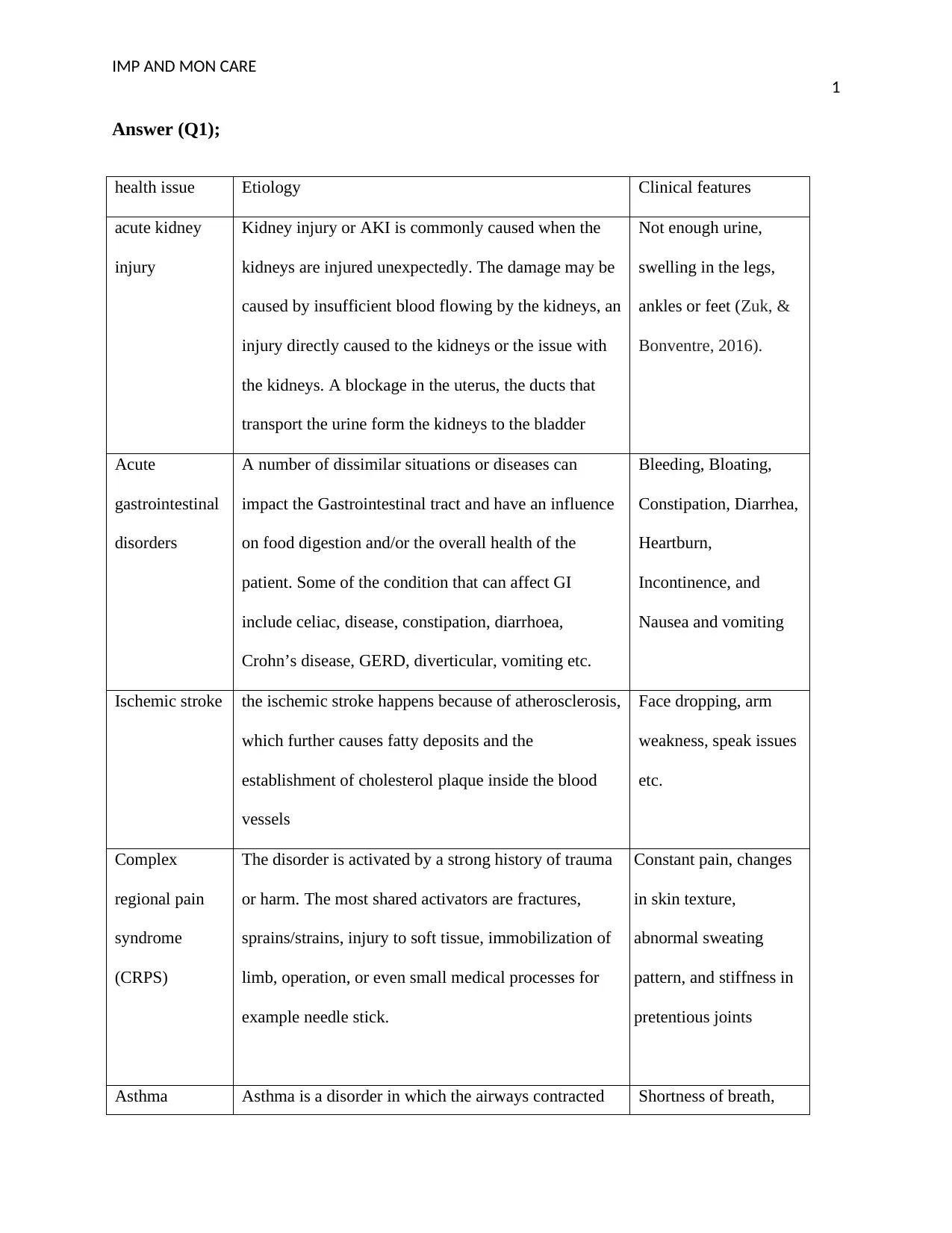
IMP AND MON CARE
1
Answer (Q1);
health issue Etiology Clinical features
acute kidney
injury
Kidney injury or AKI is commonly caused when the
kidneys are injured unexpectedly. The damage may be
caused by insufficient blood flowing by the kidneys, an
injury directly caused to the kidneys or the issue with
the kidneys. A blockage in the uterus, the ducts that
transport the urine form the kidneys to the bladder
Not enough urine,
swelling in the legs,
ankles or feet (Zuk, &
Bonventre, 2016).
Acute
gastrointestinal
disorders
A number of dissimilar situations or diseases can
impact the Gastrointestinal tract and have an influence
on food digestion and/or the overall health of the
patient. Some of the condition that can affect GI
include celiac, disease, constipation, diarrhoea,
Crohn’s disease, GERD, diverticular, vomiting etc.
Bleeding, Bloating,
Constipation, Diarrhea,
Heartburn,
Incontinence, and
Nausea and vomiting
Ischemic stroke the ischemic stroke happens because of atherosclerosis,
which further causes fatty deposits and the
establishment of cholesterol plaque inside the blood
vessels
Face dropping, arm
weakness, speak issues
etc.
Complex
regional pain
syndrome
(CRPS)
The disorder is activated by a strong history of trauma
or harm. The most shared activators are fractures,
sprains/strains, injury to soft tissue, immobilization of
limb, operation, or even small medical processes for
example needle stick.
Constant pain, changes
in skin texture,
abnormal sweating
pattern, and stiffness in
pretentious joints
Asthma Asthma is a disorder in which the airways contracted Shortness of breath,
1
Answer (Q1);
health issue Etiology Clinical features
acute kidney
injury
Kidney injury or AKI is commonly caused when the
kidneys are injured unexpectedly. The damage may be
caused by insufficient blood flowing by the kidneys, an
injury directly caused to the kidneys or the issue with
the kidneys. A blockage in the uterus, the ducts that
transport the urine form the kidneys to the bladder
Not enough urine,
swelling in the legs,
ankles or feet (Zuk, &
Bonventre, 2016).
Acute
gastrointestinal
disorders
A number of dissimilar situations or diseases can
impact the Gastrointestinal tract and have an influence
on food digestion and/or the overall health of the
patient. Some of the condition that can affect GI
include celiac, disease, constipation, diarrhoea,
Crohn’s disease, GERD, diverticular, vomiting etc.
Bleeding, Bloating,
Constipation, Diarrhea,
Heartburn,
Incontinence, and
Nausea and vomiting
Ischemic stroke the ischemic stroke happens because of atherosclerosis,
which further causes fatty deposits and the
establishment of cholesterol plaque inside the blood
vessels
Face dropping, arm
weakness, speak issues
etc.
Complex
regional pain
syndrome
(CRPS)
The disorder is activated by a strong history of trauma
or harm. The most shared activators are fractures,
sprains/strains, injury to soft tissue, immobilization of
limb, operation, or even small medical processes for
example needle stick.
Constant pain, changes
in skin texture,
abnormal sweating
pattern, and stiffness in
pretentious joints
Asthma Asthma is a disorder in which the airways contracted Shortness of breath,
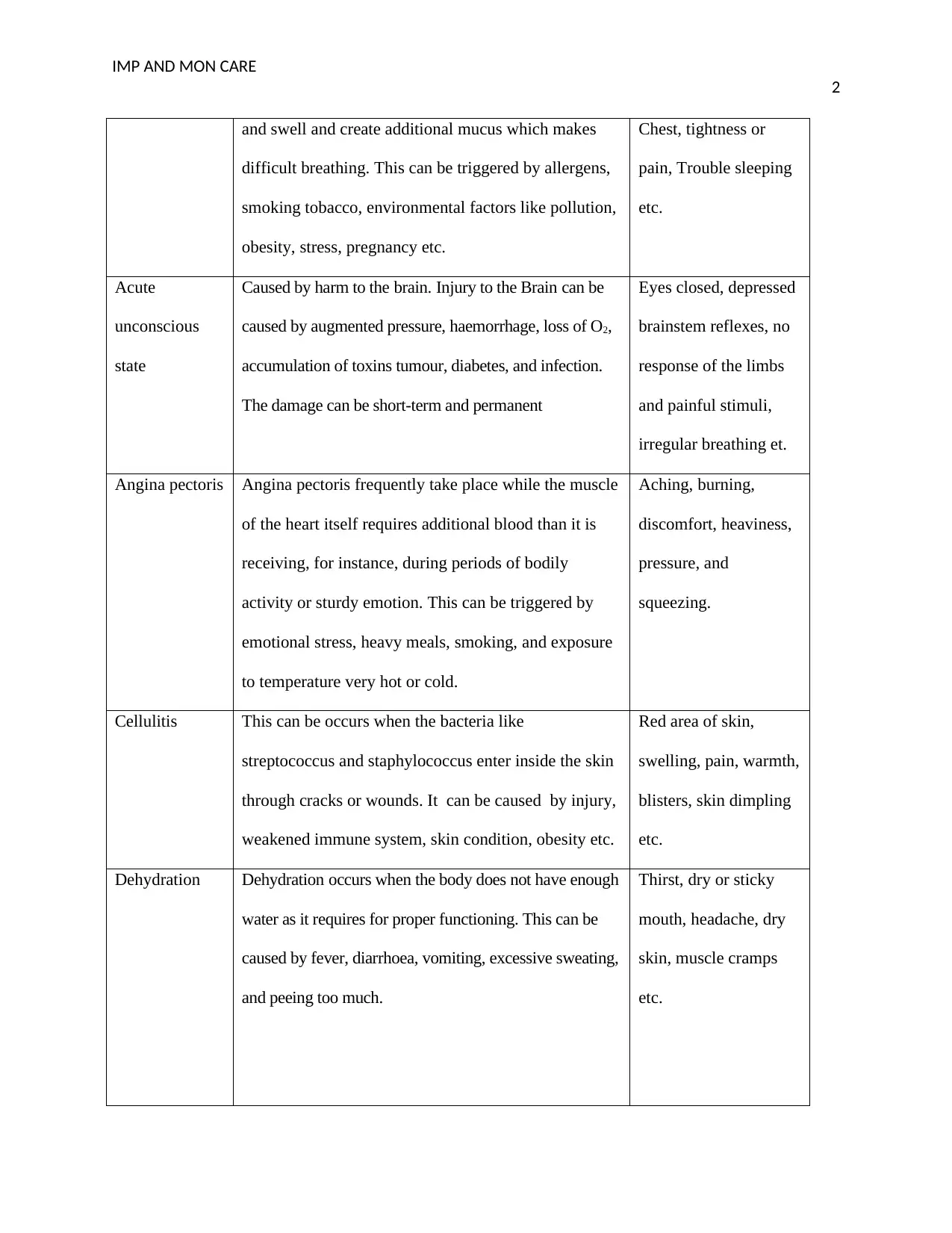
IMP AND MON CARE
2
and swell and create additional mucus which makes
difficult breathing. This can be triggered by allergens,
smoking tobacco, environmental factors like pollution,
obesity, stress, pregnancy etc.
Chest, tightness or
pain, Trouble sleeping
etc.
Acute
unconscious
state
Caused by harm to the brain. Injury to the Brain can be
caused by augmented pressure, haemorrhage, loss of O2,
accumulation of toxins tumour, diabetes, and infection.
The damage can be short-term and permanent
Eyes closed, depressed
brainstem reflexes, no
response of the limbs
and painful stimuli,
irregular breathing et.
Angina pectoris Angina pectoris frequently take place while the muscle
of the heart itself requires additional blood than it is
receiving, for instance, during periods of bodily
activity or sturdy emotion. This can be triggered by
emotional stress, heavy meals, smoking, and exposure
to temperature very hot or cold.
Aching, burning,
discomfort, heaviness,
pressure, and
squeezing.
Cellulitis This can be occurs when the bacteria like
streptococcus and staphylococcus enter inside the skin
through cracks or wounds. It can be caused by injury,
weakened immune system, skin condition, obesity etc.
Red area of skin,
swelling, pain, warmth,
blisters, skin dimpling
etc.
Dehydration Dehydration occurs when the body does not have enough
water as it requires for proper functioning. This can be
caused by fever, diarrhoea, vomiting, excessive sweating,
and peeing too much.
Thirst, dry or sticky
mouth, headache, dry
skin, muscle cramps
etc.
2
and swell and create additional mucus which makes
difficult breathing. This can be triggered by allergens,
smoking tobacco, environmental factors like pollution,
obesity, stress, pregnancy etc.
Chest, tightness or
pain, Trouble sleeping
etc.
Acute
unconscious
state
Caused by harm to the brain. Injury to the Brain can be
caused by augmented pressure, haemorrhage, loss of O2,
accumulation of toxins tumour, diabetes, and infection.
The damage can be short-term and permanent
Eyes closed, depressed
brainstem reflexes, no
response of the limbs
and painful stimuli,
irregular breathing et.
Angina pectoris Angina pectoris frequently take place while the muscle
of the heart itself requires additional blood than it is
receiving, for instance, during periods of bodily
activity or sturdy emotion. This can be triggered by
emotional stress, heavy meals, smoking, and exposure
to temperature very hot or cold.
Aching, burning,
discomfort, heaviness,
pressure, and
squeezing.
Cellulitis This can be occurs when the bacteria like
streptococcus and staphylococcus enter inside the skin
through cracks or wounds. It can be caused by injury,
weakened immune system, skin condition, obesity etc.
Red area of skin,
swelling, pain, warmth,
blisters, skin dimpling
etc.
Dehydration Dehydration occurs when the body does not have enough
water as it requires for proper functioning. This can be
caused by fever, diarrhoea, vomiting, excessive sweating,
and peeing too much.
Thirst, dry or sticky
mouth, headache, dry
skin, muscle cramps
etc.
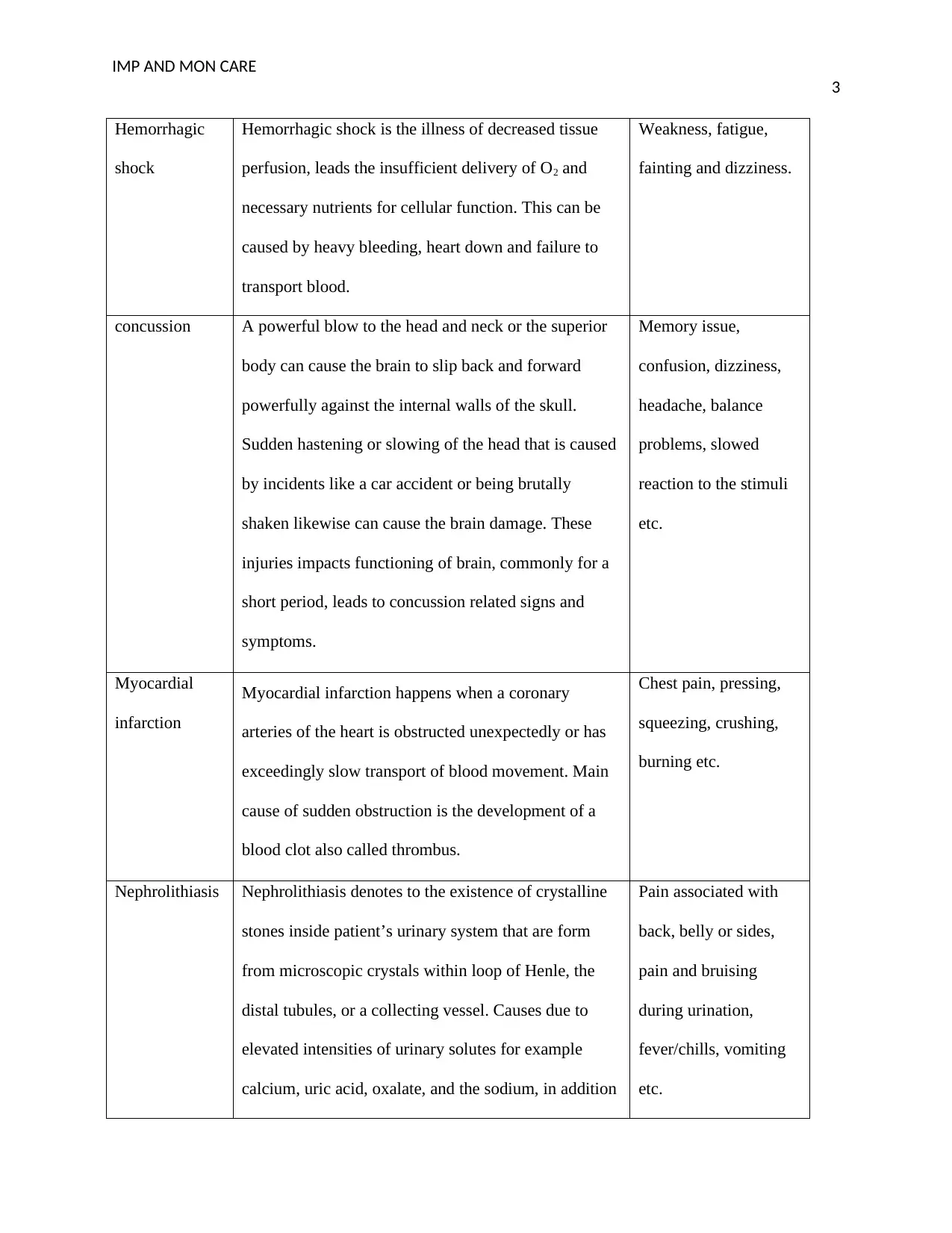
IMP AND MON CARE
3
Hemorrhagic
shock
Hemorrhagic shock is the illness of decreased tissue
perfusion, leads the insufficient delivery of O2 and
necessary nutrients for cellular function. This can be
caused by heavy bleeding, heart down and failure to
transport blood.
Weakness, fatigue,
fainting and dizziness.
concussion A powerful blow to the head and neck or the superior
body can cause the brain to slip back and forward
powerfully against the internal walls of the skull.
Sudden hastening or slowing of the head that is caused
by incidents like a car accident or being brutally
shaken likewise can cause the brain damage. These
injuries impacts functioning of brain, commonly for a
short period, leads to concussion related signs and
symptoms.
Memory issue,
confusion, dizziness,
headache, balance
problems, slowed
reaction to the stimuli
etc.
Myocardial
infarction
Myocardial infarction happens when a coronary
arteries of the heart is obstructed unexpectedly or has
exceedingly slow transport of blood movement. Main
cause of sudden obstruction is the development of a
blood clot also called thrombus.
Chest pain, pressing,
squeezing, crushing,
burning etc.
Nephrolithiasis Nephrolithiasis denotes to the existence of crystalline
stones inside patient’s urinary system that are form
from microscopic crystals within loop of Henle, the
distal tubules, or a collecting vessel. Causes due to
elevated intensities of urinary solutes for example
calcium, uric acid, oxalate, and the sodium, in addition
Pain associated with
back, belly or sides,
pain and bruising
during urination,
fever/chills, vomiting
etc.
3
Hemorrhagic
shock
Hemorrhagic shock is the illness of decreased tissue
perfusion, leads the insufficient delivery of O2 and
necessary nutrients for cellular function. This can be
caused by heavy bleeding, heart down and failure to
transport blood.
Weakness, fatigue,
fainting and dizziness.
concussion A powerful blow to the head and neck or the superior
body can cause the brain to slip back and forward
powerfully against the internal walls of the skull.
Sudden hastening or slowing of the head that is caused
by incidents like a car accident or being brutally
shaken likewise can cause the brain damage. These
injuries impacts functioning of brain, commonly for a
short period, leads to concussion related signs and
symptoms.
Memory issue,
confusion, dizziness,
headache, balance
problems, slowed
reaction to the stimuli
etc.
Myocardial
infarction
Myocardial infarction happens when a coronary
arteries of the heart is obstructed unexpectedly or has
exceedingly slow transport of blood movement. Main
cause of sudden obstruction is the development of a
blood clot also called thrombus.
Chest pain, pressing,
squeezing, crushing,
burning etc.
Nephrolithiasis Nephrolithiasis denotes to the existence of crystalline
stones inside patient’s urinary system that are form
from microscopic crystals within loop of Henle, the
distal tubules, or a collecting vessel. Causes due to
elevated intensities of urinary solutes for example
calcium, uric acid, oxalate, and the sodium, in addition
Pain associated with
back, belly or sides,
pain and bruising
during urination,
fever/chills, vomiting
etc.
Secure Best Marks with AI Grader
Need help grading? Try our AI Grader for instant feedback on your assignments.
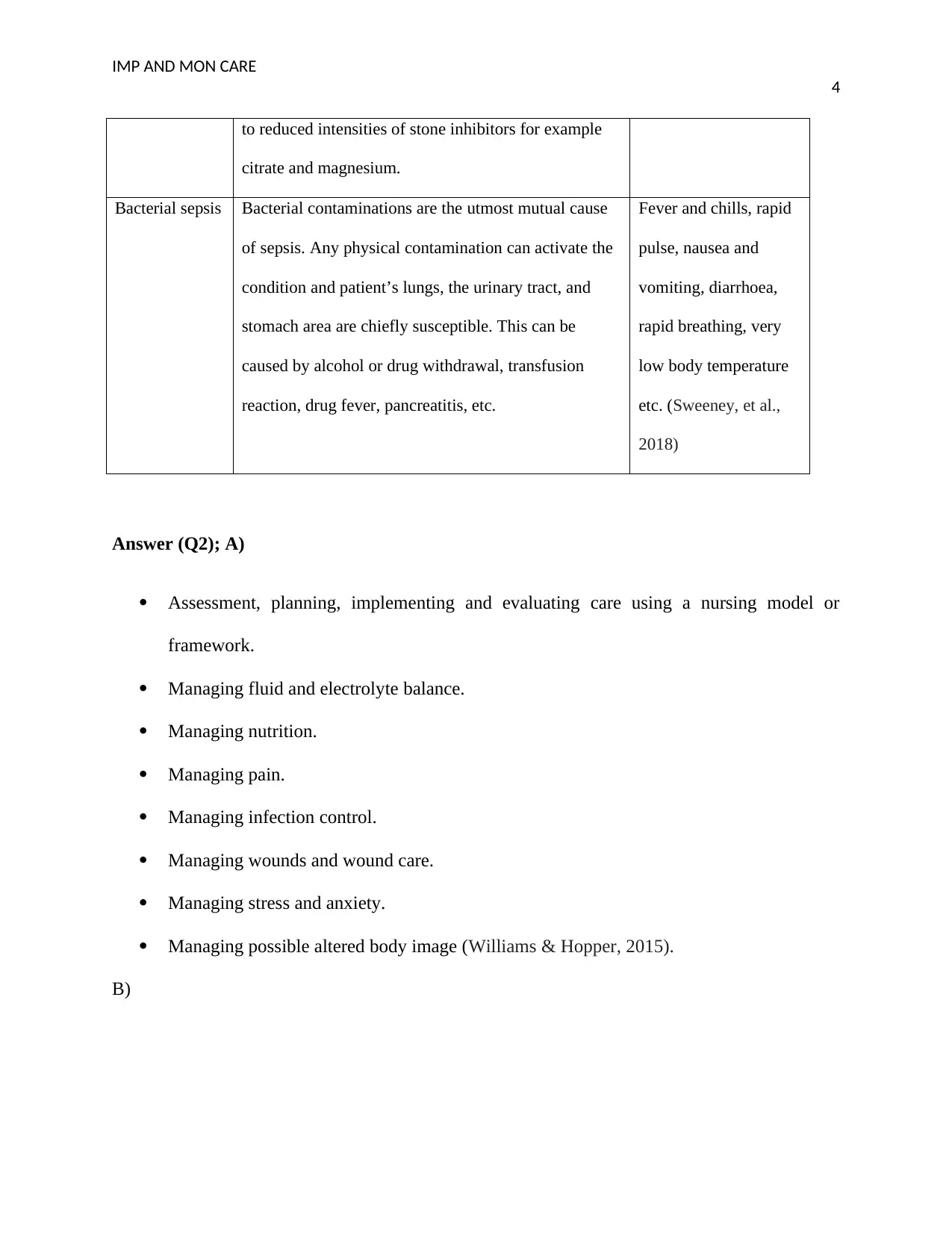
IMP AND MON CARE
4
to reduced intensities of stone inhibitors for example
citrate and magnesium.
Bacterial sepsis Bacterial contaminations are the utmost mutual cause
of sepsis. Any physical contamination can activate the
condition and patient’s lungs, the urinary tract, and
stomach area are chiefly susceptible. This can be
caused by alcohol or drug withdrawal, transfusion
reaction, drug fever, pancreatitis, etc.
Fever and chills, rapid
pulse, nausea and
vomiting, diarrhoea,
rapid breathing, very
low body temperature
etc. (Sweeney, et al.,
2018)
Answer (Q2); A)
Assessment, planning, implementing and evaluating care using a nursing model or
framework.
Managing fluid and electrolyte balance.
Managing nutrition.
Managing pain.
Managing infection control.
Managing wounds and wound care.
Managing stress and anxiety.
Managing possible altered body image (Williams & Hopper, 2015).
B)
4
to reduced intensities of stone inhibitors for example
citrate and magnesium.
Bacterial sepsis Bacterial contaminations are the utmost mutual cause
of sepsis. Any physical contamination can activate the
condition and patient’s lungs, the urinary tract, and
stomach area are chiefly susceptible. This can be
caused by alcohol or drug withdrawal, transfusion
reaction, drug fever, pancreatitis, etc.
Fever and chills, rapid
pulse, nausea and
vomiting, diarrhoea,
rapid breathing, very
low body temperature
etc. (Sweeney, et al.,
2018)
Answer (Q2); A)
Assessment, planning, implementing and evaluating care using a nursing model or
framework.
Managing fluid and electrolyte balance.
Managing nutrition.
Managing pain.
Managing infection control.
Managing wounds and wound care.
Managing stress and anxiety.
Managing possible altered body image (Williams & Hopper, 2015).
B)
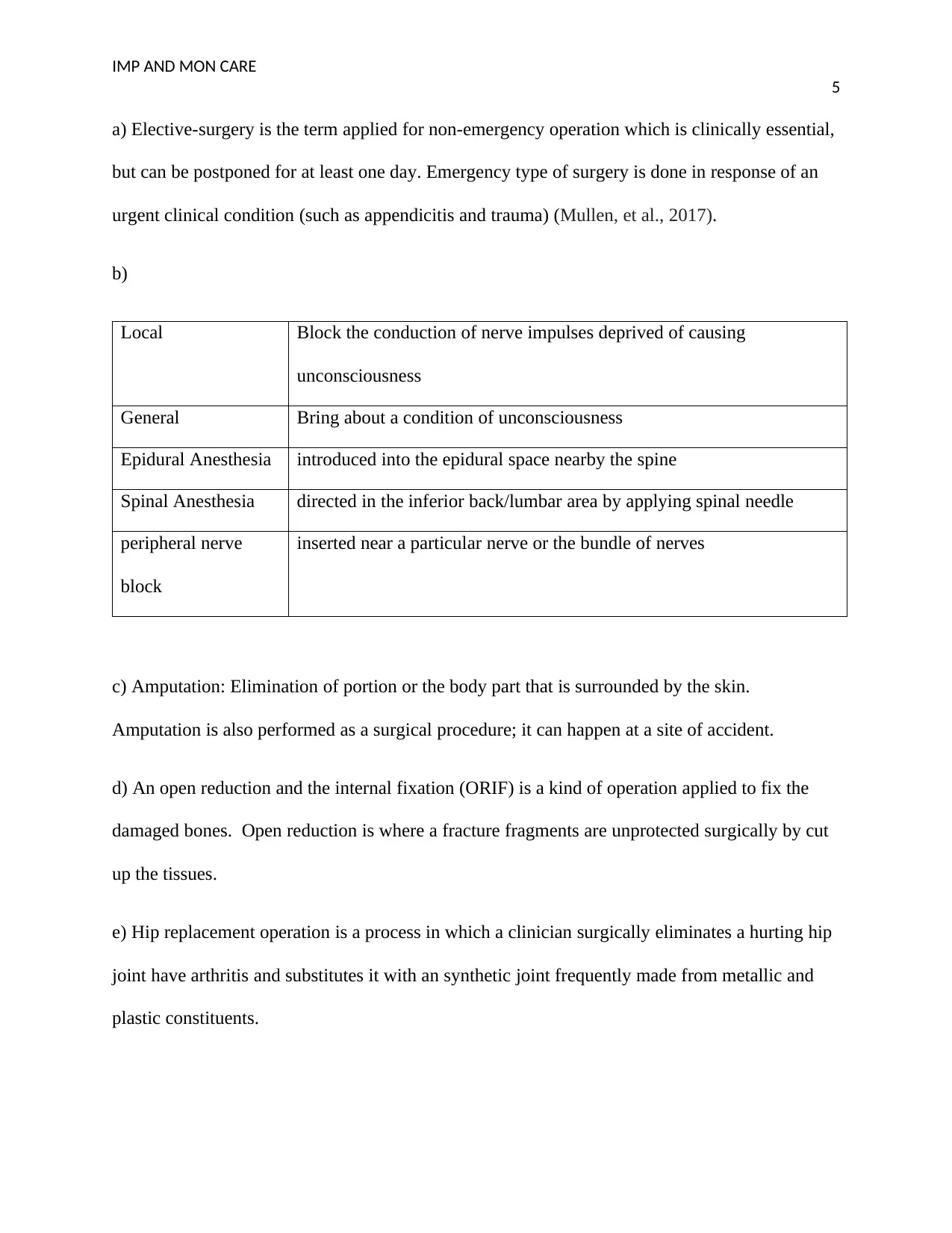
IMP AND MON CARE
5
a) Elective-surgery is the term applied for non-emergency operation which is clinically essential,
but can be postponed for at least one day. Emergency type of surgery is done in response of an
urgent clinical condition (such as appendicitis and trauma) (Mullen, et al., 2017).
b)
Local Block the conduction of nerve impulses deprived of causing
unconsciousness
General Bring about a condition of unconsciousness
Epidural Anesthesia introduced into the epidural space nearby the spine
Spinal Anesthesia directed in the inferior back/lumbar area by applying spinal needle
peripheral nerve
block
inserted near a particular nerve or the bundle of nerves
c) Amputation: Elimination of portion or the body part that is surrounded by the skin.
Amputation is also performed as a surgical procedure; it can happen at a site of accident.
d) An open reduction and the internal fixation (ORIF) is a kind of operation applied to fix the
damaged bones. Open reduction is where a fracture fragments are unprotected surgically by cut
up the tissues.
e) Hip replacement operation is a process in which a clinician surgically eliminates a hurting hip
joint have arthritis and substitutes it with an synthetic joint frequently made from metallic and
plastic constituents.
5
a) Elective-surgery is the term applied for non-emergency operation which is clinically essential,
but can be postponed for at least one day. Emergency type of surgery is done in response of an
urgent clinical condition (such as appendicitis and trauma) (Mullen, et al., 2017).
b)
Local Block the conduction of nerve impulses deprived of causing
unconsciousness
General Bring about a condition of unconsciousness
Epidural Anesthesia introduced into the epidural space nearby the spine
Spinal Anesthesia directed in the inferior back/lumbar area by applying spinal needle
peripheral nerve
block
inserted near a particular nerve or the bundle of nerves
c) Amputation: Elimination of portion or the body part that is surrounded by the skin.
Amputation is also performed as a surgical procedure; it can happen at a site of accident.
d) An open reduction and the internal fixation (ORIF) is a kind of operation applied to fix the
damaged bones. Open reduction is where a fracture fragments are unprotected surgically by cut
up the tissues.
e) Hip replacement operation is a process in which a clinician surgically eliminates a hurting hip
joint have arthritis and substitutes it with an synthetic joint frequently made from metallic and
plastic constituents.
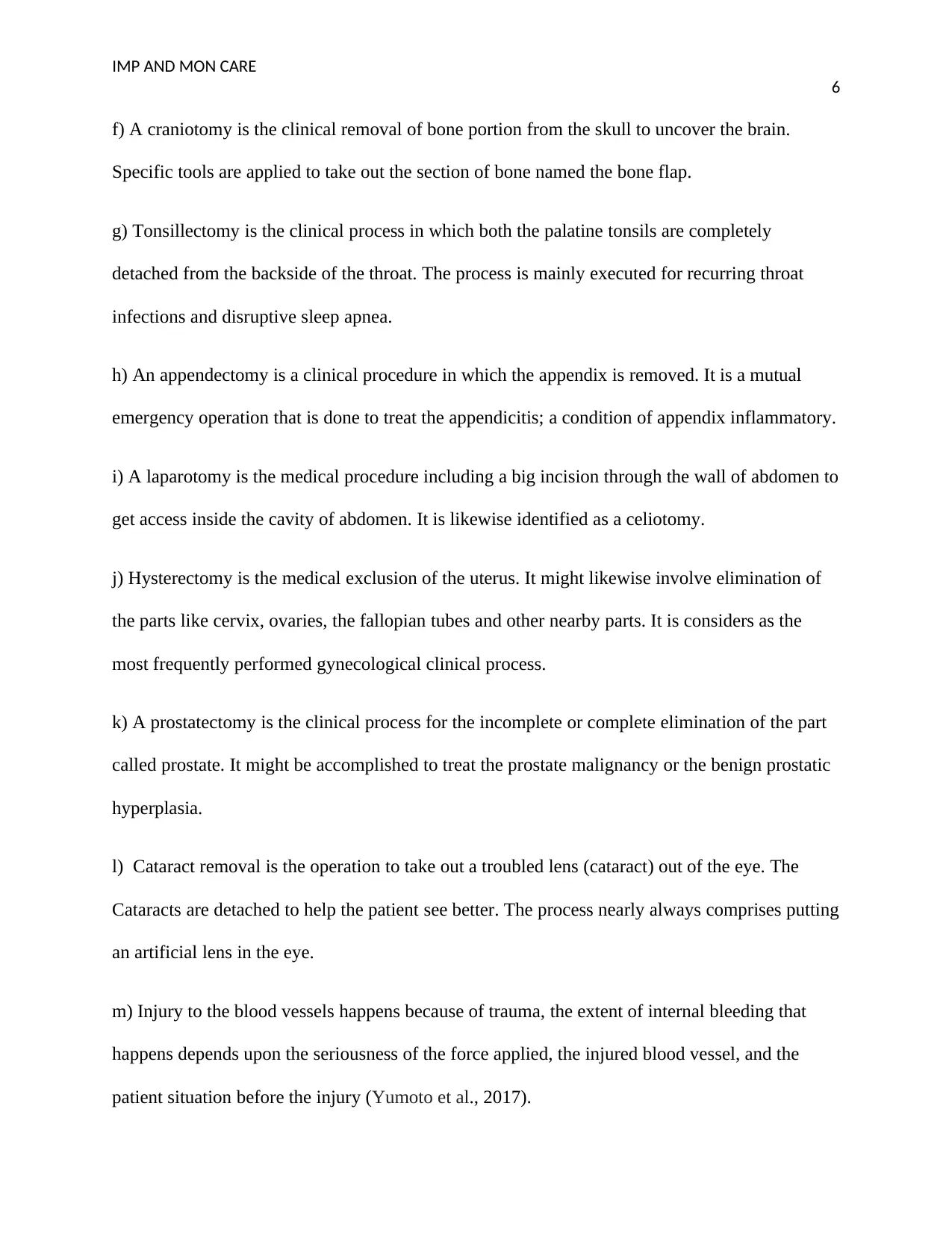
IMP AND MON CARE
6
f) A craniotomy is the clinical removal of bone portion from the skull to uncover the brain.
Specific tools are applied to take out the section of bone named the bone flap.
g) Tonsillectomy is the clinical process in which both the palatine tonsils are completely
detached from the backside of the throat. The process is mainly executed for recurring throat
infections and disruptive sleep apnea.
h) An appendectomy is a clinical procedure in which the appendix is removed. It is a mutual
emergency operation that is done to treat the appendicitis; a condition of appendix inflammatory.
i) A laparotomy is the medical procedure including a big incision through the wall of abdomen to
get access inside the cavity of abdomen. It is likewise identified as a celiotomy.
j) Hysterectomy is the medical exclusion of the uterus. It might likewise involve elimination of
the parts like cervix, ovaries, the fallopian tubes and other nearby parts. It is considers as the
most frequently performed gynecological clinical process.
k) A prostatectomy is the clinical process for the incomplete or complete elimination of the part
called prostate. It might be accomplished to treat the prostate malignancy or the benign prostatic
hyperplasia.
l) Cataract removal is the operation to take out a troubled lens (cataract) out of the eye. The
Cataracts are detached to help the patient see better. The process nearly always comprises putting
an artificial lens in the eye.
m) Injury to the blood vessels happens because of trauma, the extent of internal bleeding that
happens depends upon the seriousness of the force applied, the injured blood vessel, and the
patient situation before the injury (Yumoto et al., 2017).
6
f) A craniotomy is the clinical removal of bone portion from the skull to uncover the brain.
Specific tools are applied to take out the section of bone named the bone flap.
g) Tonsillectomy is the clinical process in which both the palatine tonsils are completely
detached from the backside of the throat. The process is mainly executed for recurring throat
infections and disruptive sleep apnea.
h) An appendectomy is a clinical procedure in which the appendix is removed. It is a mutual
emergency operation that is done to treat the appendicitis; a condition of appendix inflammatory.
i) A laparotomy is the medical procedure including a big incision through the wall of abdomen to
get access inside the cavity of abdomen. It is likewise identified as a celiotomy.
j) Hysterectomy is the medical exclusion of the uterus. It might likewise involve elimination of
the parts like cervix, ovaries, the fallopian tubes and other nearby parts. It is considers as the
most frequently performed gynecological clinical process.
k) A prostatectomy is the clinical process for the incomplete or complete elimination of the part
called prostate. It might be accomplished to treat the prostate malignancy or the benign prostatic
hyperplasia.
l) Cataract removal is the operation to take out a troubled lens (cataract) out of the eye. The
Cataracts are detached to help the patient see better. The process nearly always comprises putting
an artificial lens in the eye.
m) Injury to the blood vessels happens because of trauma, the extent of internal bleeding that
happens depends upon the seriousness of the force applied, the injured blood vessel, and the
patient situation before the injury (Yumoto et al., 2017).
Paraphrase This Document
Need a fresh take? Get an instant paraphrase of this document with our AI Paraphraser
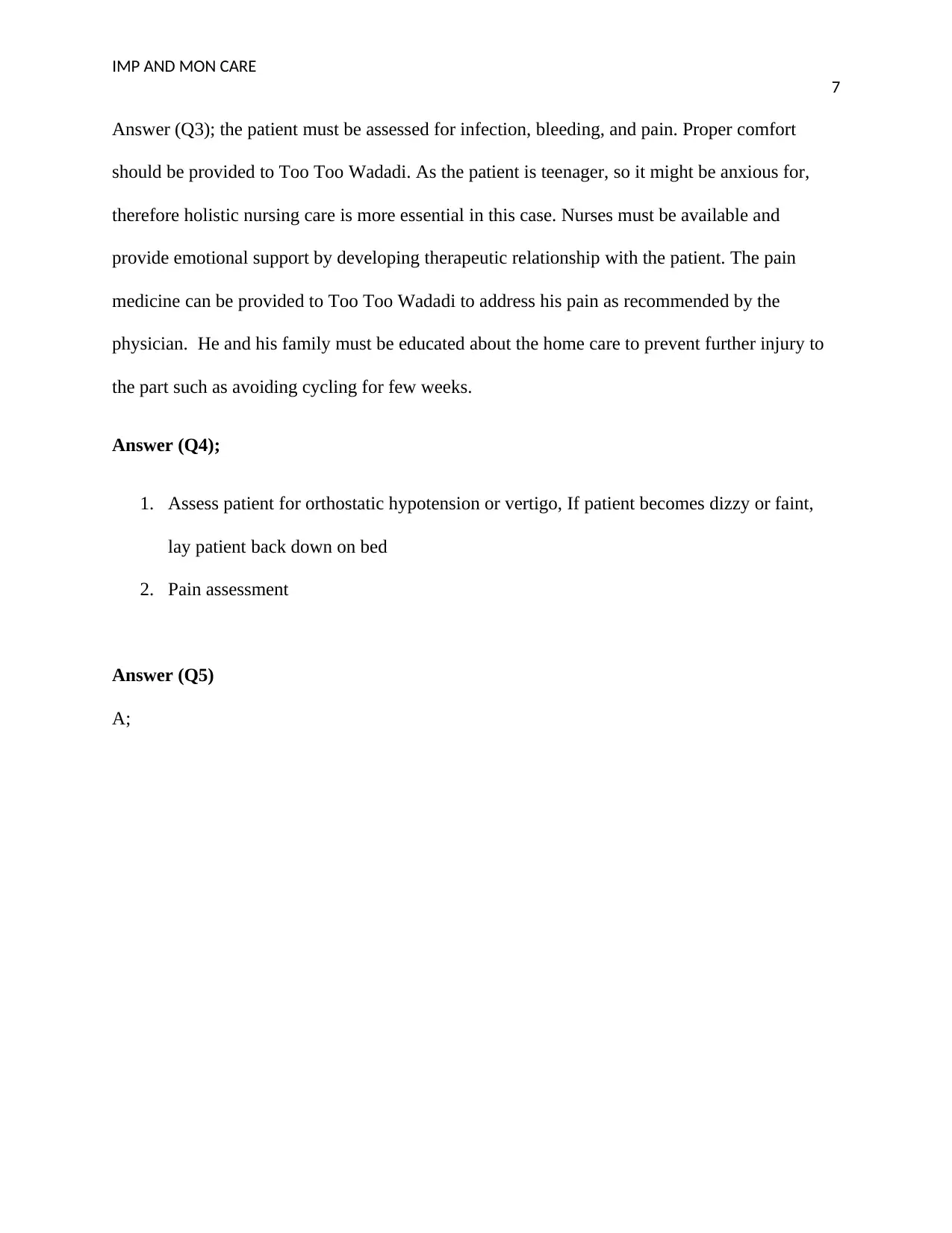
IMP AND MON CARE
7
Answer (Q3); the patient must be assessed for infection, bleeding, and pain. Proper comfort
should be provided to Too Too Wadadi. As the patient is teenager, so it might be anxious for,
therefore holistic nursing care is more essential in this case. Nurses must be available and
provide emotional support by developing therapeutic relationship with the patient. The pain
medicine can be provided to Too Too Wadadi to address his pain as recommended by the
physician. He and his family must be educated about the home care to prevent further injury to
the part such as avoiding cycling for few weeks.
Answer (Q4);
1. Assess patient for orthostatic hypotension or vertigo, If patient becomes dizzy or faint,
lay patient back down on bed
2. Pain assessment
Answer (Q5)
A;
7
Answer (Q3); the patient must be assessed for infection, bleeding, and pain. Proper comfort
should be provided to Too Too Wadadi. As the patient is teenager, so it might be anxious for,
therefore holistic nursing care is more essential in this case. Nurses must be available and
provide emotional support by developing therapeutic relationship with the patient. The pain
medicine can be provided to Too Too Wadadi to address his pain as recommended by the
physician. He and his family must be educated about the home care to prevent further injury to
the part such as avoiding cycling for few weeks.
Answer (Q4);
1. Assess patient for orthostatic hypotension or vertigo, If patient becomes dizzy or faint,
lay patient back down on bed
2. Pain assessment
Answer (Q5)
A;
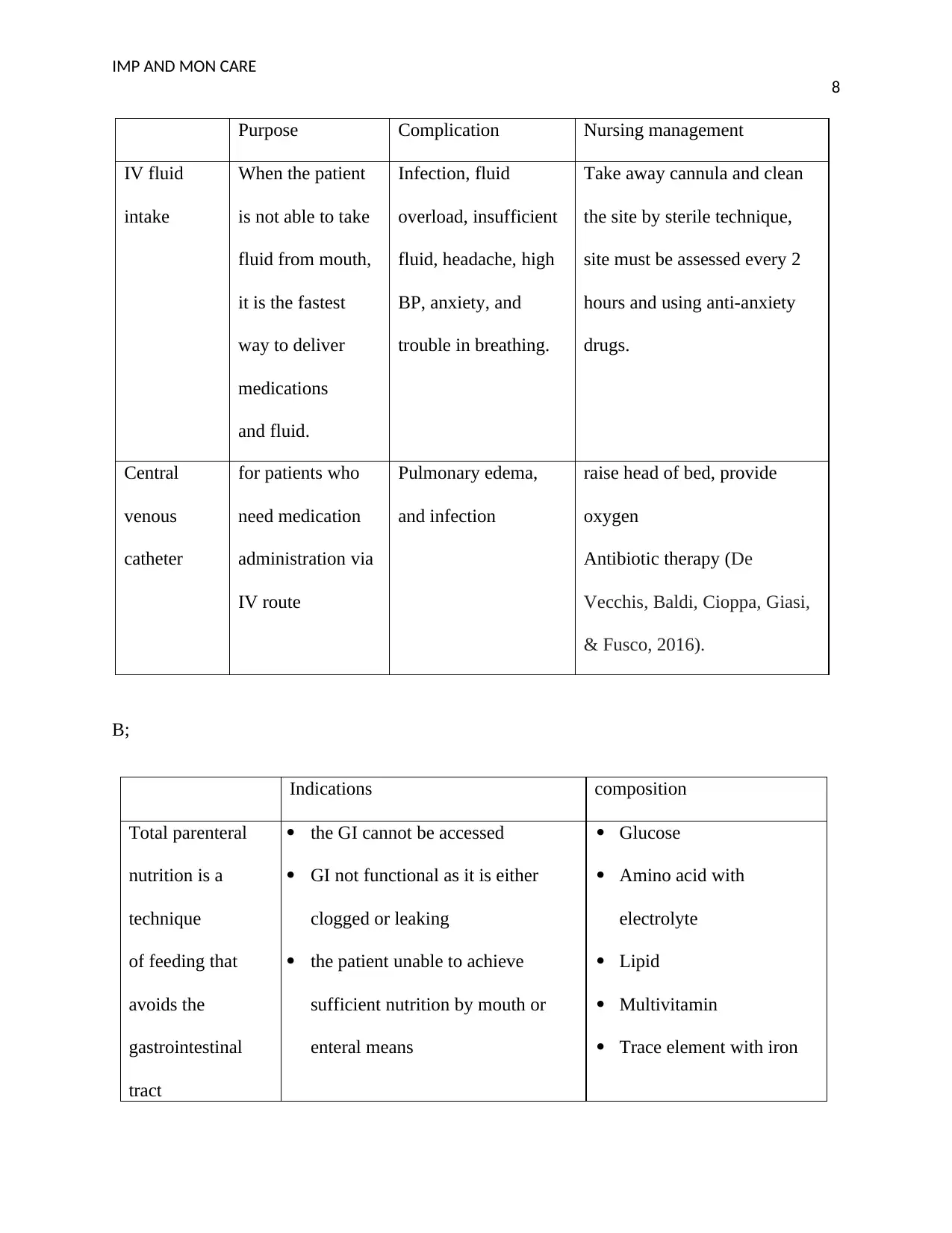
IMP AND MON CARE
8
Purpose Complication Nursing management
IV fluid
intake
When the patient
is not able to take
fluid from mouth,
it is the fastest
way to deliver
medications
and fluid.
Infection, fluid
overload, insufficient
fluid, headache, high
BP, anxiety, and
trouble in breathing.
Take away cannula and clean
the site by sterile technique,
site must be assessed every 2
hours and using anti-anxiety
drugs.
Central
venous
catheter
for patients who
need medication
administration via
IV route
Pulmonary edema,
and infection
raise head of bed, provide
oxygen
Antibiotic therapy (De
Vecchis, Baldi, Cioppa, Giasi,
& Fusco, 2016).
B;
Indications composition
Total parenteral
nutrition is a
technique
of feeding that
avoids the
gastrointestinal
tract
the GI cannot be accessed
GI not functional as it is either
clogged or leaking
the patient unable to achieve
sufficient nutrition by mouth or
enteral means
Glucose
Amino acid with
electrolyte
Lipid
Multivitamin
Trace element with iron
8
Purpose Complication Nursing management
IV fluid
intake
When the patient
is not able to take
fluid from mouth,
it is the fastest
way to deliver
medications
and fluid.
Infection, fluid
overload, insufficient
fluid, headache, high
BP, anxiety, and
trouble in breathing.
Take away cannula and clean
the site by sterile technique,
site must be assessed every 2
hours and using anti-anxiety
drugs.
Central
venous
catheter
for patients who
need medication
administration via
IV route
Pulmonary edema,
and infection
raise head of bed, provide
oxygen
Antibiotic therapy (De
Vecchis, Baldi, Cioppa, Giasi,
& Fusco, 2016).
B;
Indications composition
Total parenteral
nutrition is a
technique
of feeding that
avoids the
gastrointestinal
tract
the GI cannot be accessed
GI not functional as it is either
clogged or leaking
the patient unable to achieve
sufficient nutrition by mouth or
enteral means
Glucose
Amino acid with
electrolyte
Lipid
Multivitamin
Trace element with iron
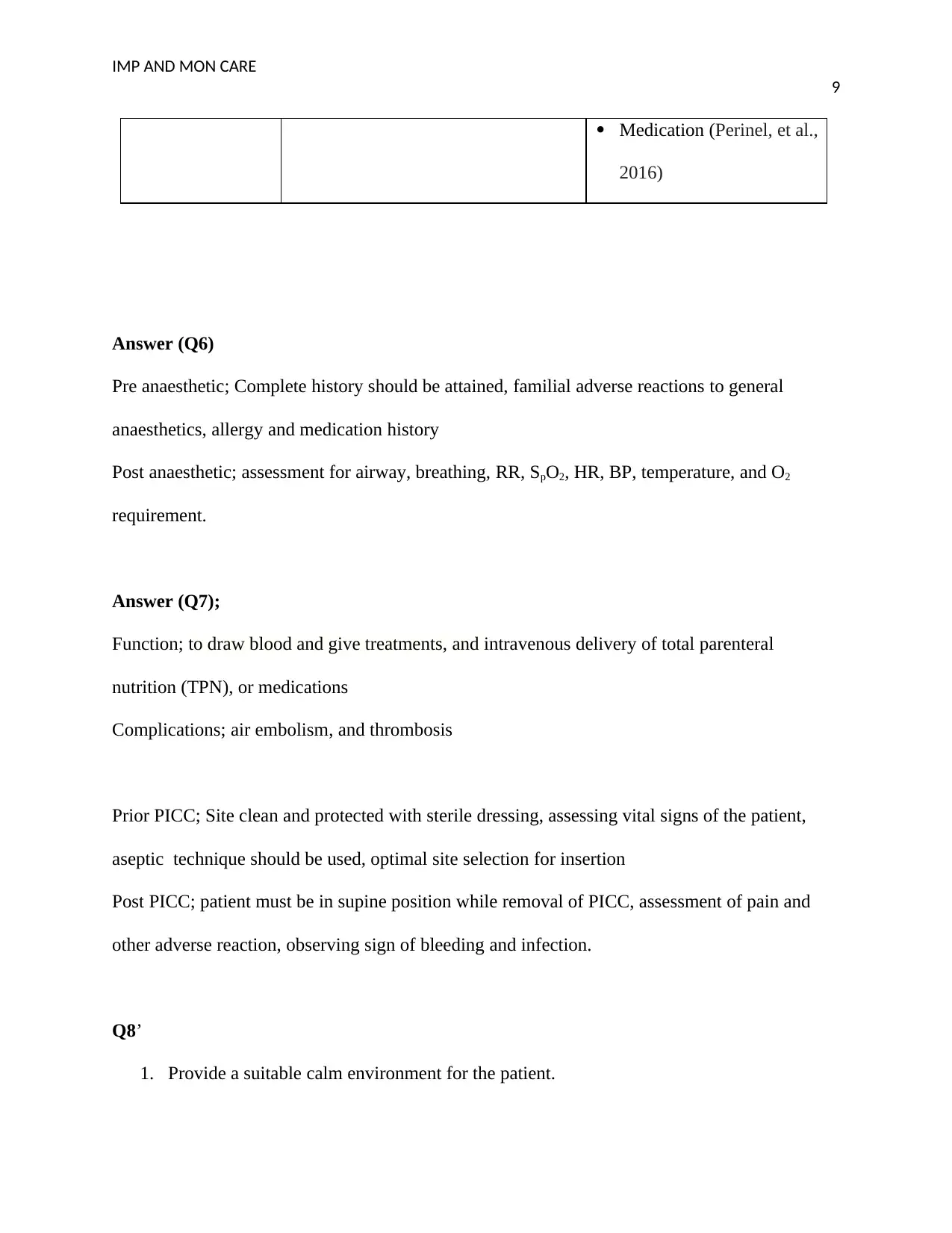
IMP AND MON CARE
9
Medication (Perinel, et al.,
2016)
Answer (Q6)
Pre anaesthetic; Complete history should be attained, familial adverse reactions to general
anaesthetics, allergy and medication history
Post anaesthetic; assessment for airway, breathing, RR, SpO2, HR, BP, temperature, and O2
requirement.
Answer (Q7);
Function; to draw blood and give treatments, and intravenous delivery of total parenteral
nutrition (TPN), or medications
Complications; air embolism, and thrombosis
Prior PICC; Site clean and protected with sterile dressing, assessing vital signs of the patient,
aseptic technique should be used, optimal site selection for insertion
Post PICC; patient must be in supine position while removal of PICC, assessment of pain and
other adverse reaction, observing sign of bleeding and infection.
Q8’
1. Provide a suitable calm environment for the patient.
9
Medication (Perinel, et al.,
2016)
Answer (Q6)
Pre anaesthetic; Complete history should be attained, familial adverse reactions to general
anaesthetics, allergy and medication history
Post anaesthetic; assessment for airway, breathing, RR, SpO2, HR, BP, temperature, and O2
requirement.
Answer (Q7);
Function; to draw blood and give treatments, and intravenous delivery of total parenteral
nutrition (TPN), or medications
Complications; air embolism, and thrombosis
Prior PICC; Site clean and protected with sterile dressing, assessing vital signs of the patient,
aseptic technique should be used, optimal site selection for insertion
Post PICC; patient must be in supine position while removal of PICC, assessment of pain and
other adverse reaction, observing sign of bleeding and infection.
Q8’
1. Provide a suitable calm environment for the patient.
Secure Best Marks with AI Grader
Need help grading? Try our AI Grader for instant feedback on your assignments.
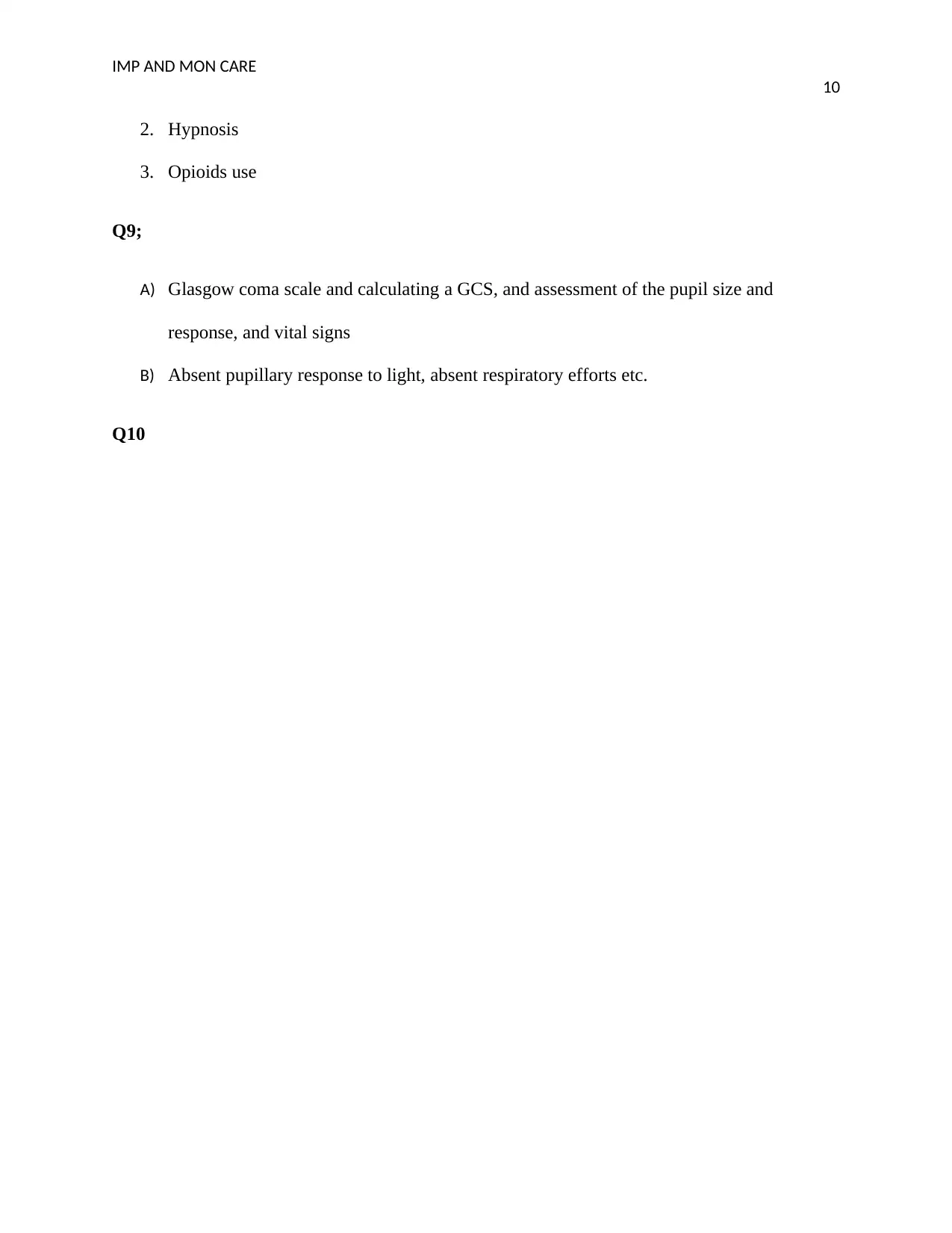
IMP AND MON CARE
10
2. Hypnosis
3. Opioids use
Q9;
A) Glasgow coma scale and calculating a GCS, and assessment of the pupil size and
response, and vital signs
B) Absent pupillary response to light, absent respiratory efforts etc.
Q10
10
2. Hypnosis
3. Opioids use
Q9;
A) Glasgow coma scale and calculating a GCS, and assessment of the pupil size and
response, and vital signs
B) Absent pupillary response to light, absent respiratory efforts etc.
Q10
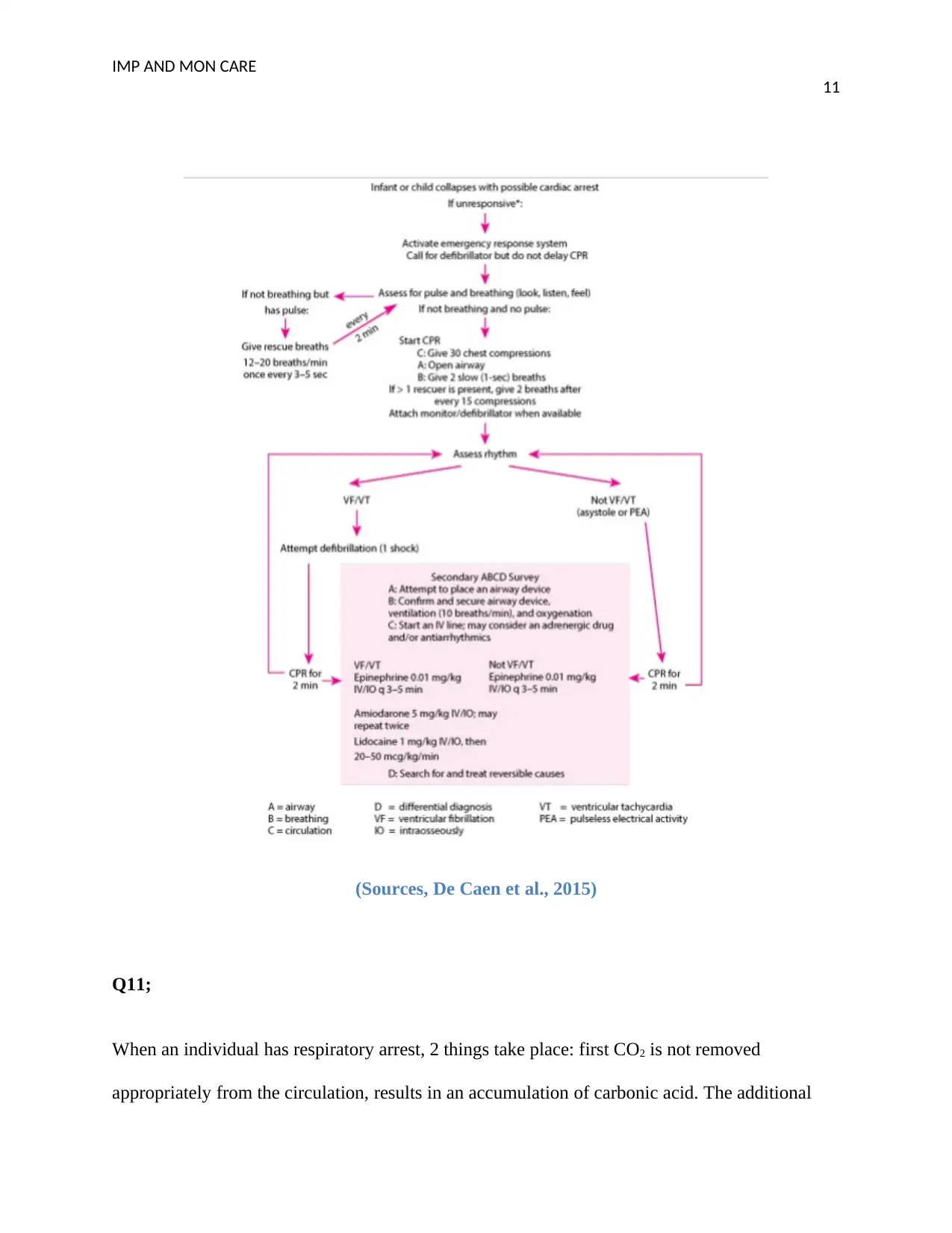
IMP AND MON CARE
11
(Sources, De Caen et al., 2015)
Q11;
When an individual has respiratory arrest, 2 things take place: first CO2 is not removed
appropriately from the circulation, results in an accumulation of carbonic acid. The additional
11
(Sources, De Caen et al., 2015)
Q11;
When an individual has respiratory arrest, 2 things take place: first CO2 is not removed
appropriately from the circulation, results in an accumulation of carbonic acid. The additional
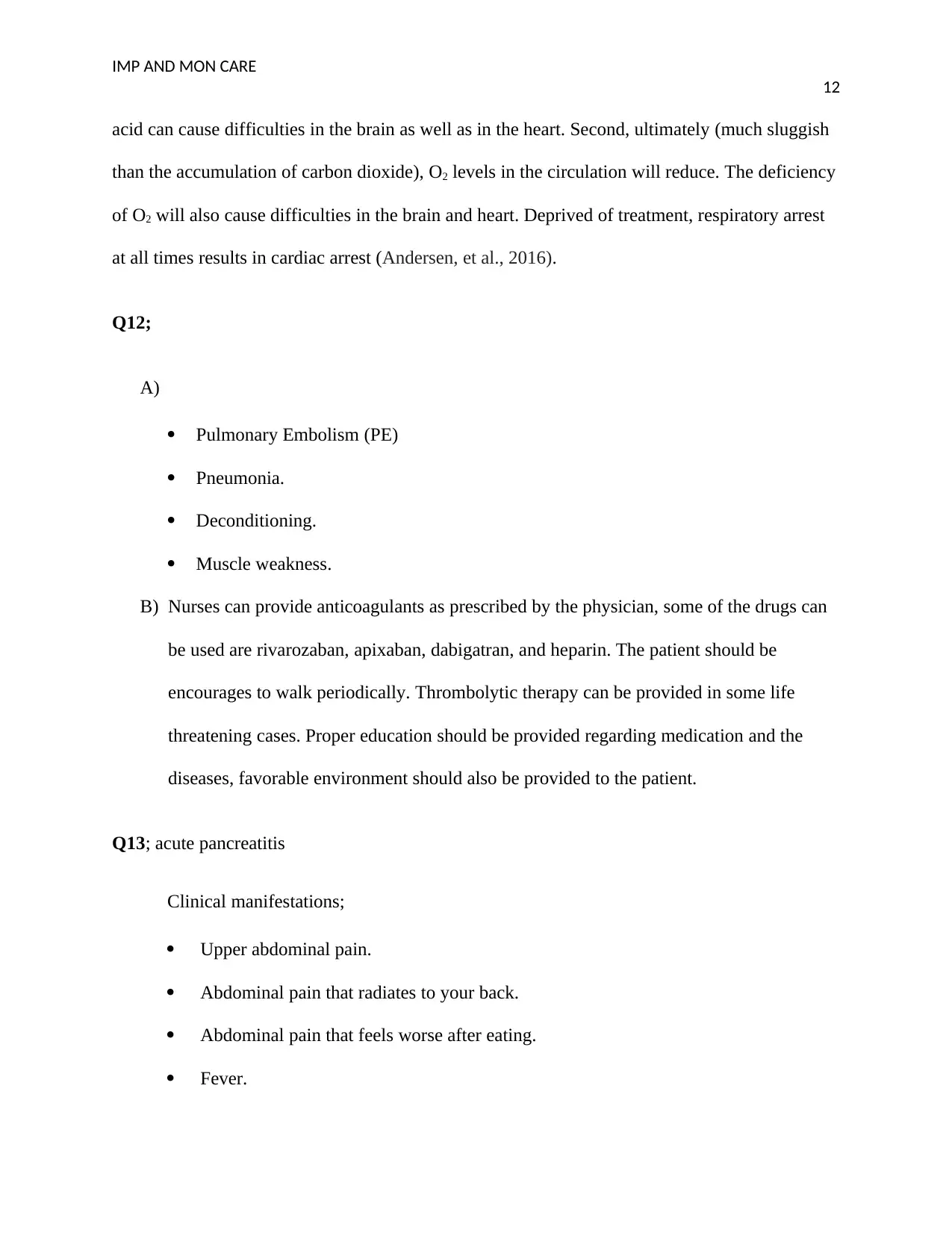
IMP AND MON CARE
12
acid can cause difficulties in the brain as well as in the heart. Second, ultimately (much sluggish
than the accumulation of carbon dioxide), O2 levels in the circulation will reduce. The deficiency
of O2 will also cause difficulties in the brain and heart. Deprived of treatment, respiratory arrest
at all times results in cardiac arrest (Andersen, et al., 2016).
Q12;
A)
Pulmonary Embolism (PE)
Pneumonia.
Deconditioning.
Muscle weakness.
B) Nurses can provide anticoagulants as prescribed by the physician, some of the drugs can
be used are rivarozaban, apixaban, dabigatran, and heparin. The patient should be
encourages to walk periodically. Thrombolytic therapy can be provided in some life
threatening cases. Proper education should be provided regarding medication and the
diseases, favorable environment should also be provided to the patient.
Q13; acute pancreatitis
Clinical manifestations;
Upper abdominal pain.
Abdominal pain that radiates to your back.
Abdominal pain that feels worse after eating.
Fever.
12
acid can cause difficulties in the brain as well as in the heart. Second, ultimately (much sluggish
than the accumulation of carbon dioxide), O2 levels in the circulation will reduce. The deficiency
of O2 will also cause difficulties in the brain and heart. Deprived of treatment, respiratory arrest
at all times results in cardiac arrest (Andersen, et al., 2016).
Q12;
A)
Pulmonary Embolism (PE)
Pneumonia.
Deconditioning.
Muscle weakness.
B) Nurses can provide anticoagulants as prescribed by the physician, some of the drugs can
be used are rivarozaban, apixaban, dabigatran, and heparin. The patient should be
encourages to walk periodically. Thrombolytic therapy can be provided in some life
threatening cases. Proper education should be provided regarding medication and the
diseases, favorable environment should also be provided to the patient.
Q13; acute pancreatitis
Clinical manifestations;
Upper abdominal pain.
Abdominal pain that radiates to your back.
Abdominal pain that feels worse after eating.
Fever.
Paraphrase This Document
Need a fresh take? Get an instant paraphrase of this document with our AI Paraphraser
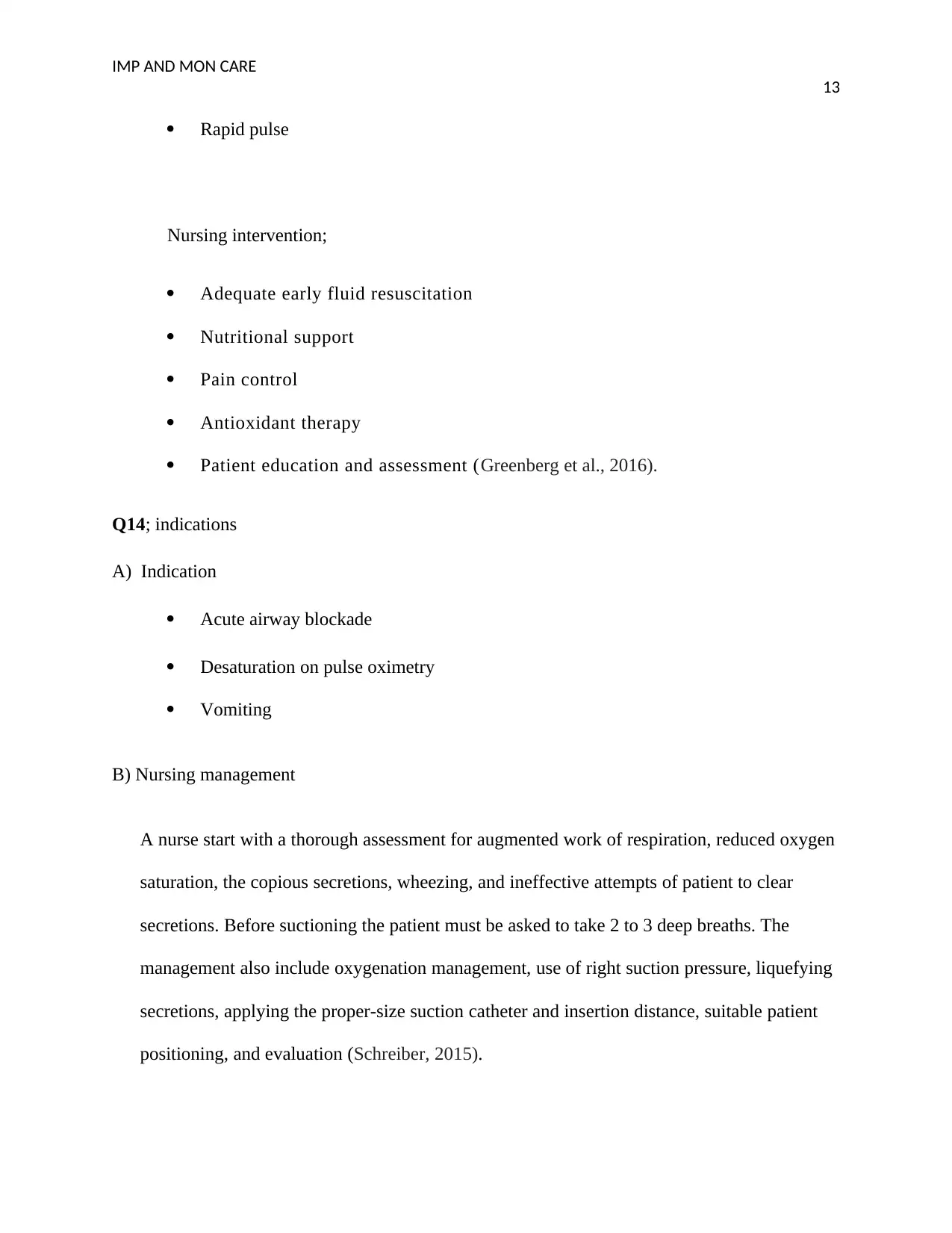
IMP AND MON CARE
13
Rapid pulse
Nursing intervention;
Adequate early fluid resuscitation
Nutritional support
Pain control
Antioxidant therapy
Patient education and assessment (Greenberg et al., 2016).
Q14; indications
A) Indication
Acute airway blockade
Desaturation on pulse oximetry
Vomiting
B) Nursing management
A nurse start with a thorough assessment for augmented work of respiration, reduced oxygen
saturation, the copious secretions, wheezing, and ineffective attempts of patient to clear
secretions. Before suctioning the patient must be asked to take 2 to 3 deep breaths. The
management also include oxygenation management, use of right suction pressure, liquefying
secretions, applying the proper-size suction catheter and insertion distance, suitable patient
positioning, and evaluation (Schreiber, 2015).
13
Rapid pulse
Nursing intervention;
Adequate early fluid resuscitation
Nutritional support
Pain control
Antioxidant therapy
Patient education and assessment (Greenberg et al., 2016).
Q14; indications
A) Indication
Acute airway blockade
Desaturation on pulse oximetry
Vomiting
B) Nursing management
A nurse start with a thorough assessment for augmented work of respiration, reduced oxygen
saturation, the copious secretions, wheezing, and ineffective attempts of patient to clear
secretions. Before suctioning the patient must be asked to take 2 to 3 deep breaths. The
management also include oxygenation management, use of right suction pressure, liquefying
secretions, applying the proper-size suction catheter and insertion distance, suitable patient
positioning, and evaluation (Schreiber, 2015).
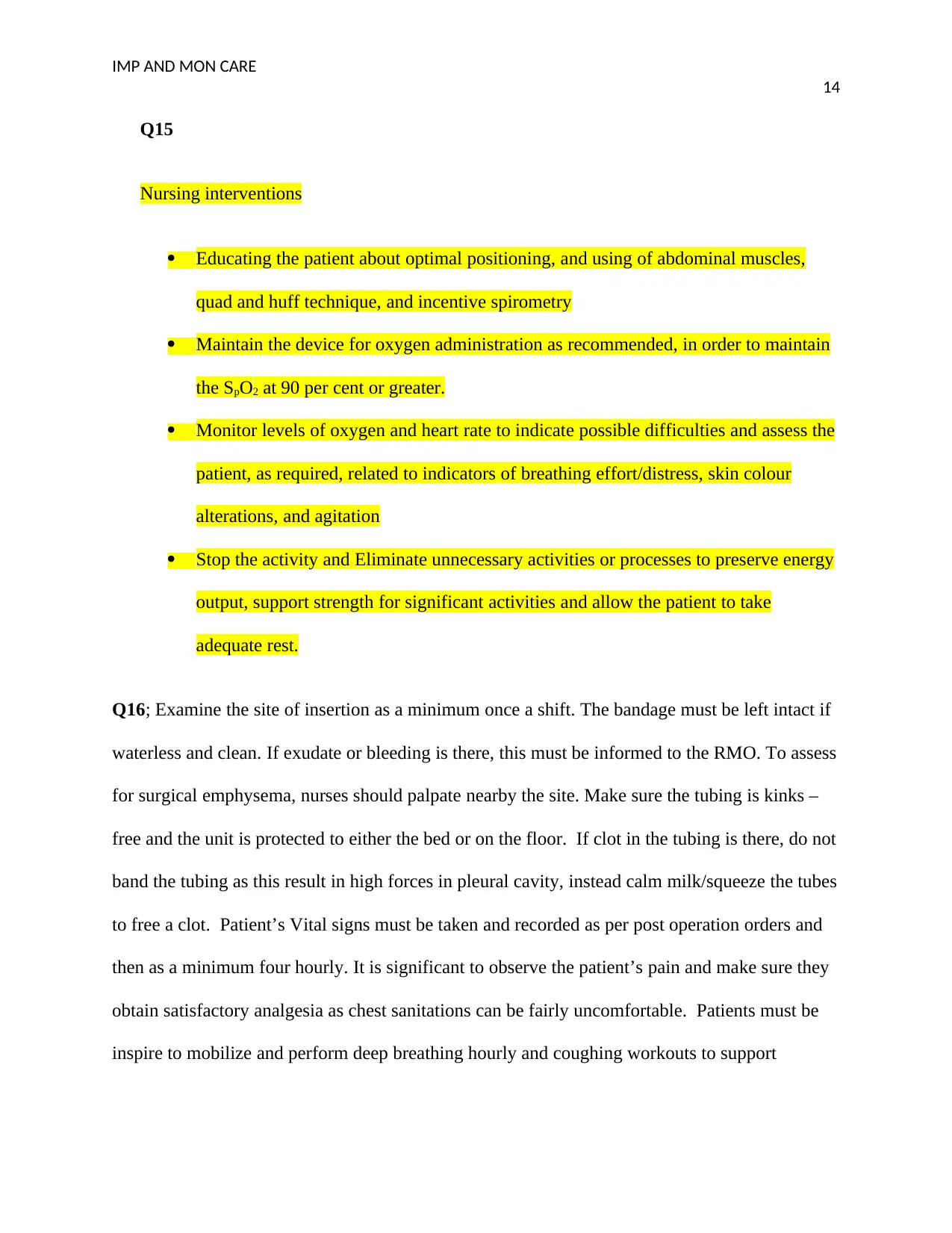
IMP AND MON CARE
14
Q15
Nursing interventions
Educating the patient about optimal positioning, and using of abdominal muscles,
quad and huff technique, and incentive spirometry
Maintain the device for oxygen administration as recommended, in order to maintain
the SpO2 at 90 per cent or greater.
Monitor levels of oxygen and heart rate to indicate possible difficulties and assess the
patient, as required, related to indicators of breathing effort/distress, skin colour
alterations, and agitation
Stop the activity and Eliminate unnecessary activities or processes to preserve energy
output, support strength for significant activities and allow the patient to take
adequate rest.
Q16; Examine the site of insertion as a minimum once a shift. The bandage must be left intact if
waterless and clean. If exudate or bleeding is there, this must be informed to the RMO. To assess
for surgical emphysema, nurses should palpate nearby the site. Make sure the tubing is kinks –
free and the unit is protected to either the bed or on the floor. If clot in the tubing is there, do not
band the tubing as this result in high forces in pleural cavity, instead calm milk/squeeze the tubes
to free a clot. Patient’s Vital signs must be taken and recorded as per post operation orders and
then as a minimum four hourly. It is significant to observe the patient’s pain and make sure they
obtain satisfactory analgesia as chest sanitations can be fairly uncomfortable. Patients must be
inspire to mobilize and perform deep breathing hourly and coughing workouts to support
14
Q15
Nursing interventions
Educating the patient about optimal positioning, and using of abdominal muscles,
quad and huff technique, and incentive spirometry
Maintain the device for oxygen administration as recommended, in order to maintain
the SpO2 at 90 per cent or greater.
Monitor levels of oxygen and heart rate to indicate possible difficulties and assess the
patient, as required, related to indicators of breathing effort/distress, skin colour
alterations, and agitation
Stop the activity and Eliminate unnecessary activities or processes to preserve energy
output, support strength for significant activities and allow the patient to take
adequate rest.
Q16; Examine the site of insertion as a minimum once a shift. The bandage must be left intact if
waterless and clean. If exudate or bleeding is there, this must be informed to the RMO. To assess
for surgical emphysema, nurses should palpate nearby the site. Make sure the tubing is kinks –
free and the unit is protected to either the bed or on the floor. If clot in the tubing is there, do not
band the tubing as this result in high forces in pleural cavity, instead calm milk/squeeze the tubes
to free a clot. Patient’s Vital signs must be taken and recorded as per post operation orders and
then as a minimum four hourly. It is significant to observe the patient’s pain and make sure they
obtain satisfactory analgesia as chest sanitations can be fairly uncomfortable. Patients must be
inspire to mobilize and perform deep breathing hourly and coughing workouts to support
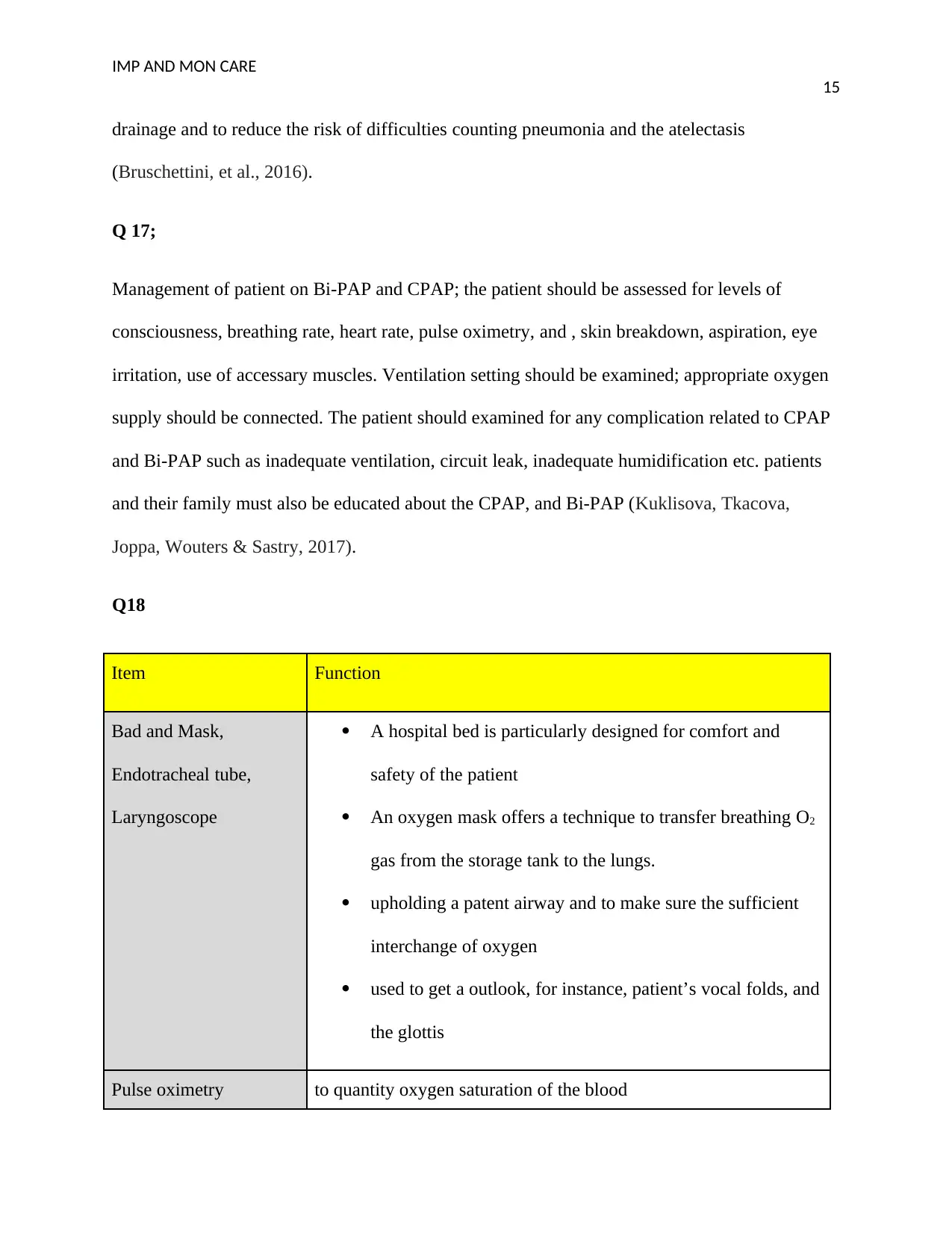
IMP AND MON CARE
15
drainage and to reduce the risk of difficulties counting pneumonia and the atelectasis
(Bruschettini, et al., 2016).
Q 17;
Management of patient on Bi-PAP and CPAP; the patient should be assessed for levels of
consciousness, breathing rate, heart rate, pulse oximetry, and , skin breakdown, aspiration, eye
irritation, use of accessary muscles. Ventilation setting should be examined; appropriate oxygen
supply should be connected. The patient should examined for any complication related to CPAP
and Bi-PAP such as inadequate ventilation, circuit leak, inadequate humidification etc. patients
and their family must also be educated about the CPAP, and Bi-PAP (Kuklisova, Tkacova,
Joppa, Wouters & Sastry, 2017).
Q18
Item Function
Bad and Mask,
Endotracheal tube,
Laryngoscope
A hospital bed is particularly designed for comfort and
safety of the patient
An oxygen mask offers a technique to transfer breathing O2
gas from the storage tank to the lungs.
upholding a patent airway and to make sure the sufficient
interchange of oxygen
used to get a outlook, for instance, patient’s vocal folds, and
the glottis
Pulse oximetry to quantity oxygen saturation of the blood
15
drainage and to reduce the risk of difficulties counting pneumonia and the atelectasis
(Bruschettini, et al., 2016).
Q 17;
Management of patient on Bi-PAP and CPAP; the patient should be assessed for levels of
consciousness, breathing rate, heart rate, pulse oximetry, and , skin breakdown, aspiration, eye
irritation, use of accessary muscles. Ventilation setting should be examined; appropriate oxygen
supply should be connected. The patient should examined for any complication related to CPAP
and Bi-PAP such as inadequate ventilation, circuit leak, inadequate humidification etc. patients
and their family must also be educated about the CPAP, and Bi-PAP (Kuklisova, Tkacova,
Joppa, Wouters & Sastry, 2017).
Q18
Item Function
Bad and Mask,
Endotracheal tube,
Laryngoscope
A hospital bed is particularly designed for comfort and
safety of the patient
An oxygen mask offers a technique to transfer breathing O2
gas from the storage tank to the lungs.
upholding a patent airway and to make sure the sufficient
interchange of oxygen
used to get a outlook, for instance, patient’s vocal folds, and
the glottis
Pulse oximetry to quantity oxygen saturation of the blood
Secure Best Marks with AI Grader
Need help grading? Try our AI Grader for instant feedback on your assignments.
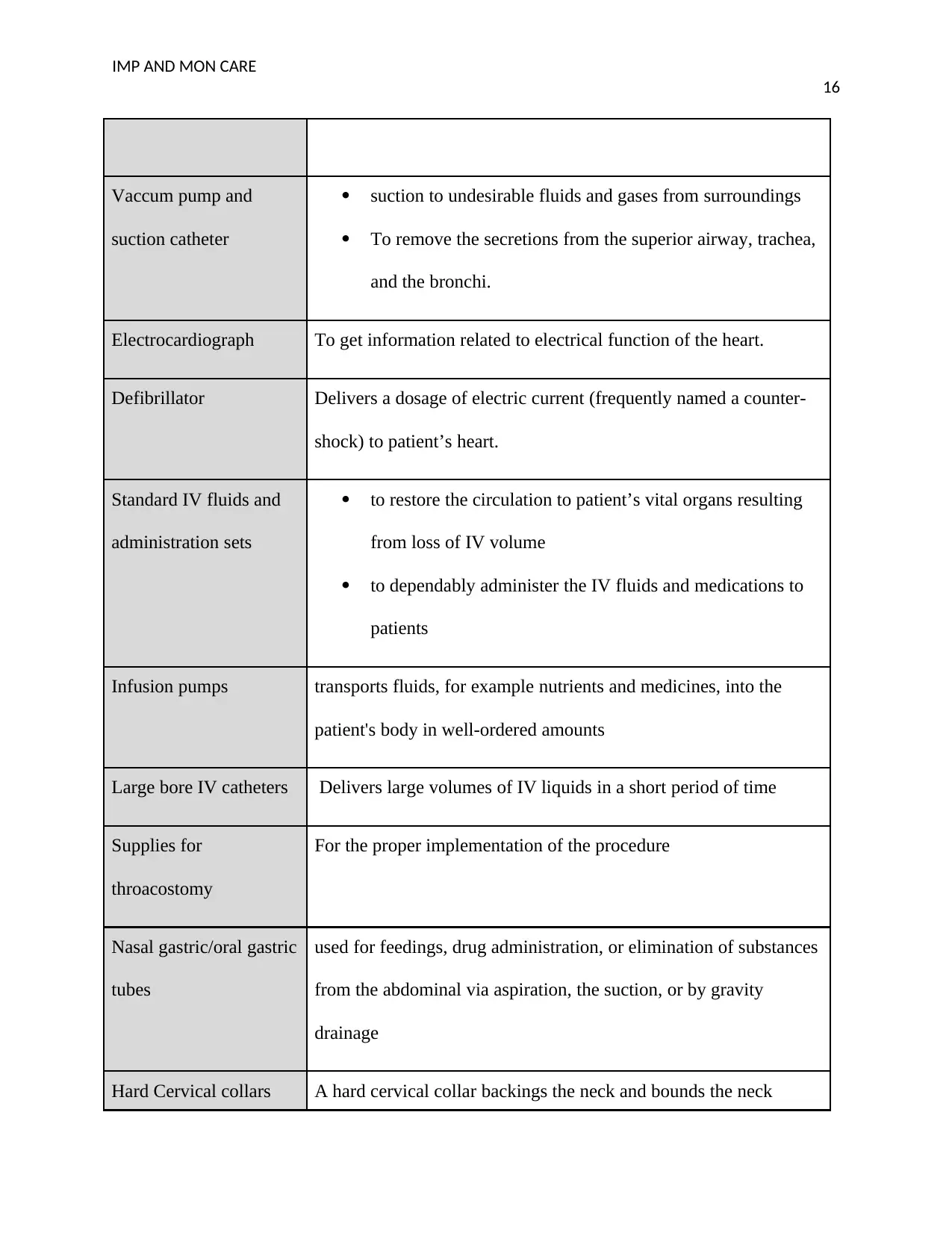
IMP AND MON CARE
16
Vaccum pump and
suction catheter
suction to undesirable fluids and gases from surroundings
To remove the secretions from the superior airway, trachea,
and the bronchi.
Electrocardiograph To get information related to electrical function of the heart.
Defibrillator Delivers a dosage of electric current (frequently named a counter-
shock) to patient’s heart.
Standard IV fluids and
administration sets
to restore the circulation to patient’s vital organs resulting
from loss of IV volume
to dependably administer the IV fluids and medications to
patients
Infusion pumps transports fluids, for example nutrients and medicines, into the
patient's body in well-ordered amounts
Large bore IV catheters Delivers large volumes of IV liquids in a short period of time
Supplies for
throacostomy
For the proper implementation of the procedure
Nasal gastric/oral gastric
tubes
used for feedings, drug administration, or elimination of substances
from the abdominal via aspiration, the suction, or by gravity
drainage
Hard Cervical collars A hard cervical collar backings the neck and bounds the neck
16
Vaccum pump and
suction catheter
suction to undesirable fluids and gases from surroundings
To remove the secretions from the superior airway, trachea,
and the bronchi.
Electrocardiograph To get information related to electrical function of the heart.
Defibrillator Delivers a dosage of electric current (frequently named a counter-
shock) to patient’s heart.
Standard IV fluids and
administration sets
to restore the circulation to patient’s vital organs resulting
from loss of IV volume
to dependably administer the IV fluids and medications to
patients
Infusion pumps transports fluids, for example nutrients and medicines, into the
patient's body in well-ordered amounts
Large bore IV catheters Delivers large volumes of IV liquids in a short period of time
Supplies for
throacostomy
For the proper implementation of the procedure
Nasal gastric/oral gastric
tubes
used for feedings, drug administration, or elimination of substances
from the abdominal via aspiration, the suction, or by gravity
drainage
Hard Cervical collars A hard cervical collar backings the neck and bounds the neck
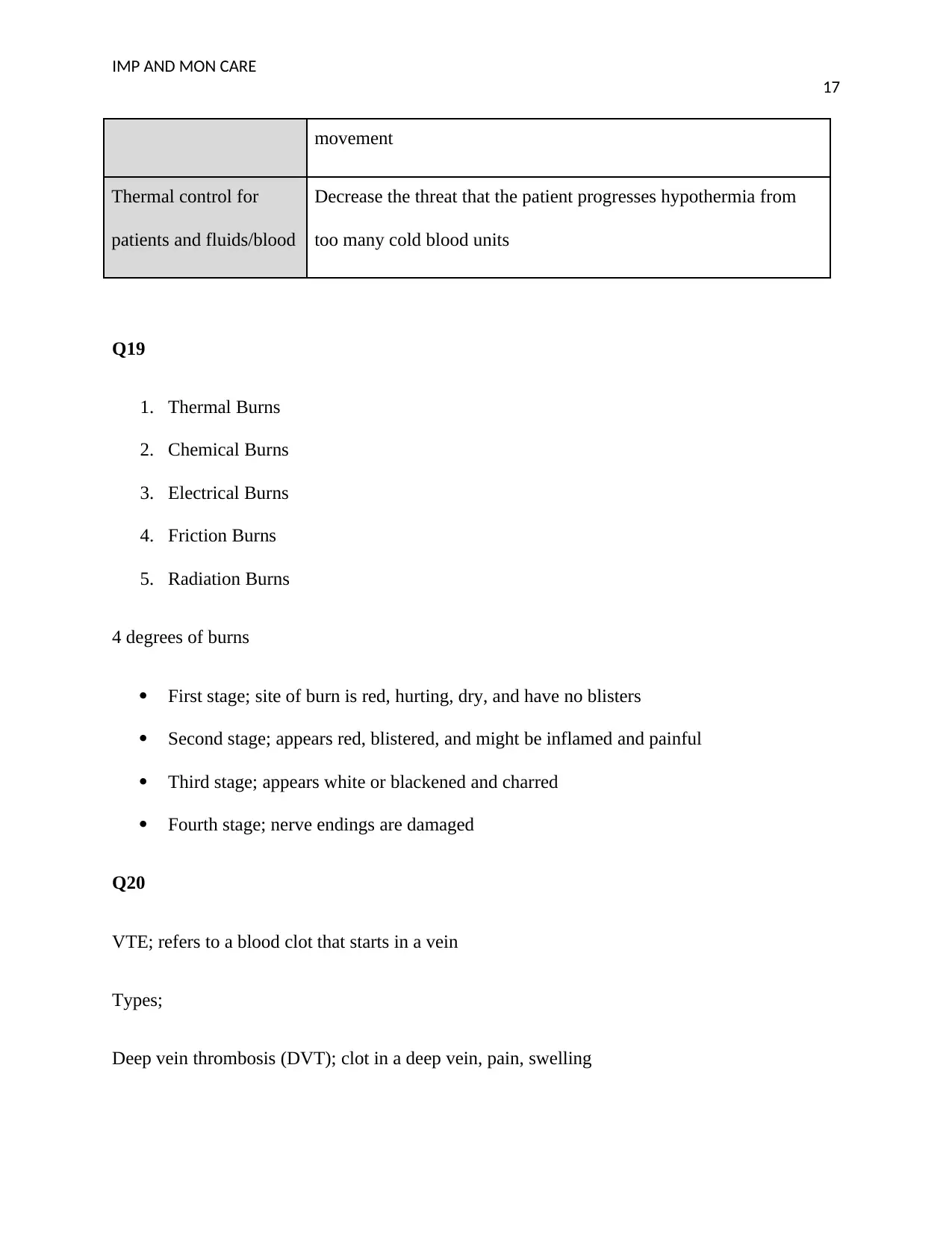
IMP AND MON CARE
17
movement
Thermal control for
patients and fluids/blood
Decrease the threat that the patient progresses hypothermia from
too many cold blood units
Q19
1. Thermal Burns
2. Chemical Burns
3. Electrical Burns
4. Friction Burns
5. Radiation Burns
4 degrees of burns
First stage; site of burn is red, hurting, dry, and have no blisters
Second stage; appears red, blistered, and might be inflamed and painful
Third stage; appears white or blackened and charred
Fourth stage; nerve endings are damaged
Q20
VTE; refers to a blood clot that starts in a vein
Types;
Deep vein thrombosis (DVT); clot in a deep vein, pain, swelling
17
movement
Thermal control for
patients and fluids/blood
Decrease the threat that the patient progresses hypothermia from
too many cold blood units
Q19
1. Thermal Burns
2. Chemical Burns
3. Electrical Burns
4. Friction Burns
5. Radiation Burns
4 degrees of burns
First stage; site of burn is red, hurting, dry, and have no blisters
Second stage; appears red, blistered, and might be inflamed and painful
Third stage; appears white or blackened and charred
Fourth stage; nerve endings are damaged
Q20
VTE; refers to a blood clot that starts in a vein
Types;
Deep vein thrombosis (DVT); clot in a deep vein, pain, swelling
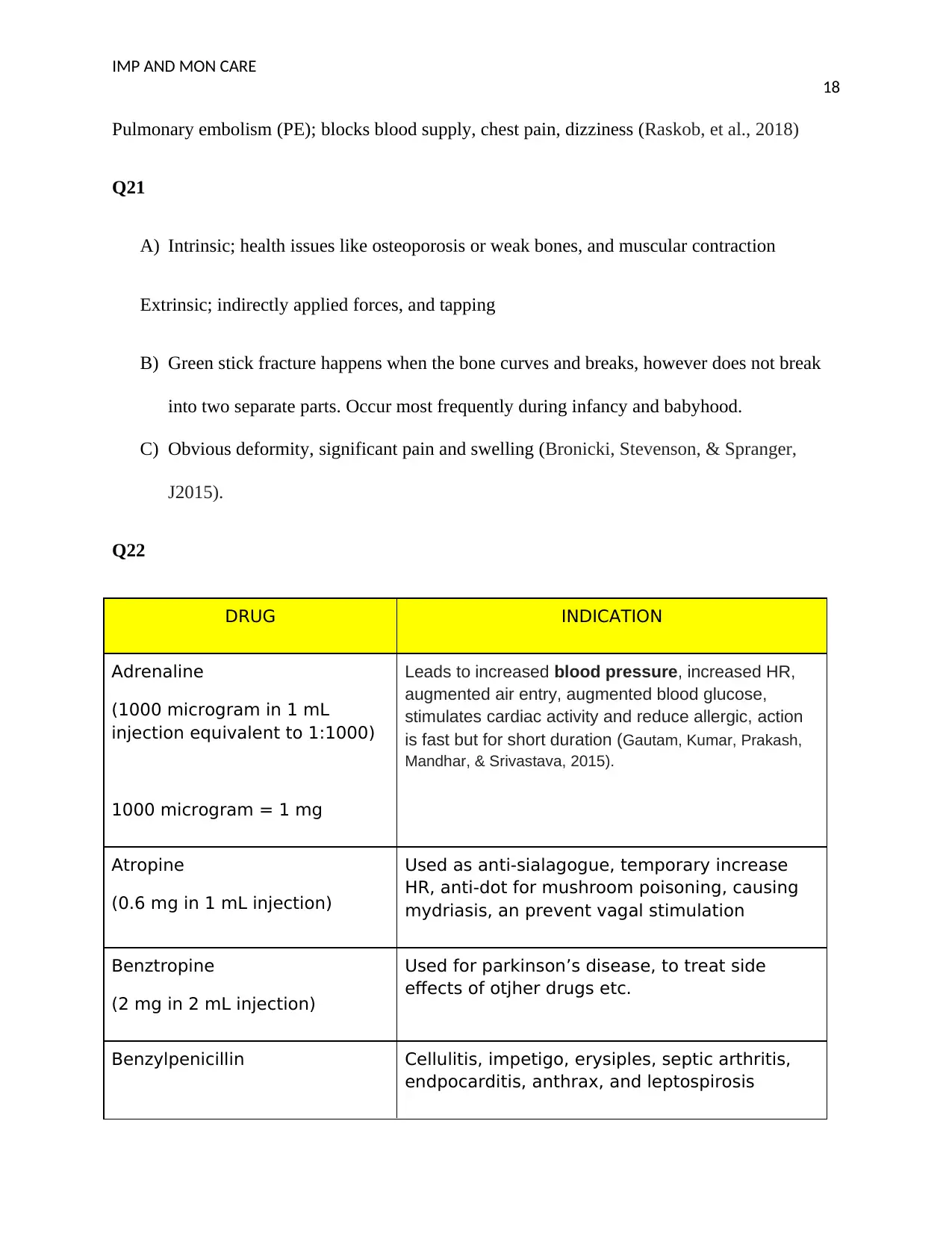
IMP AND MON CARE
18
Pulmonary embolism (PE); blocks blood supply, chest pain, dizziness (Raskob, et al., 2018)
Q21
A) Intrinsic; health issues like osteoporosis or weak bones, and muscular contraction
Extrinsic; indirectly applied forces, and tapping
B) Green stick fracture happens when the bone curves and breaks, however does not break
into two separate parts. Occur most frequently during infancy and babyhood.
C) Obvious deformity, significant pain and swelling (Bronicki, Stevenson, & Spranger,
J2015).
Q22
DRUG INDICATION
Adrenaline
(1000 microgram in 1 mL
injection equivalent to 1:1000)
1000 microgram = 1 mg
Leads to increased blood pressure, increased HR,
augmented air entry, augmented blood glucose,
stimulates cardiac activity and reduce allergic, action
is fast but for short duration (Gautam, Kumar, Prakash,
Mandhar, & Srivastava, 2015).
Atropine
(0.6 mg in 1 mL injection)
Used as anti-sialagogue, temporary increase
HR, anti-dot for mushroom poisoning, causing
mydriasis, an prevent vagal stimulation
Benztropine
(2 mg in 2 mL injection)
Used for parkinson’s disease, to treat side
effects of otjher drugs etc.
Benzylpenicillin Cellulitis, impetigo, erysiples, septic arthritis,
endpocarditis, anthrax, and leptospirosis
18
Pulmonary embolism (PE); blocks blood supply, chest pain, dizziness (Raskob, et al., 2018)
Q21
A) Intrinsic; health issues like osteoporosis or weak bones, and muscular contraction
Extrinsic; indirectly applied forces, and tapping
B) Green stick fracture happens when the bone curves and breaks, however does not break
into two separate parts. Occur most frequently during infancy and babyhood.
C) Obvious deformity, significant pain and swelling (Bronicki, Stevenson, & Spranger,
J2015).
Q22
DRUG INDICATION
Adrenaline
(1000 microgram in 1 mL
injection equivalent to 1:1000)
1000 microgram = 1 mg
Leads to increased blood pressure, increased HR,
augmented air entry, augmented blood glucose,
stimulates cardiac activity and reduce allergic, action
is fast but for short duration (Gautam, Kumar, Prakash,
Mandhar, & Srivastava, 2015).
Atropine
(0.6 mg in 1 mL injection)
Used as anti-sialagogue, temporary increase
HR, anti-dot for mushroom poisoning, causing
mydriasis, an prevent vagal stimulation
Benztropine
(2 mg in 2 mL injection)
Used for parkinson’s disease, to treat side
effects of otjher drugs etc.
Benzylpenicillin Cellulitis, impetigo, erysiples, septic arthritis,
endpocarditis, anthrax, and leptospirosis
Paraphrase This Document
Need a fresh take? Get an instant paraphrase of this document with our AI Paraphraser
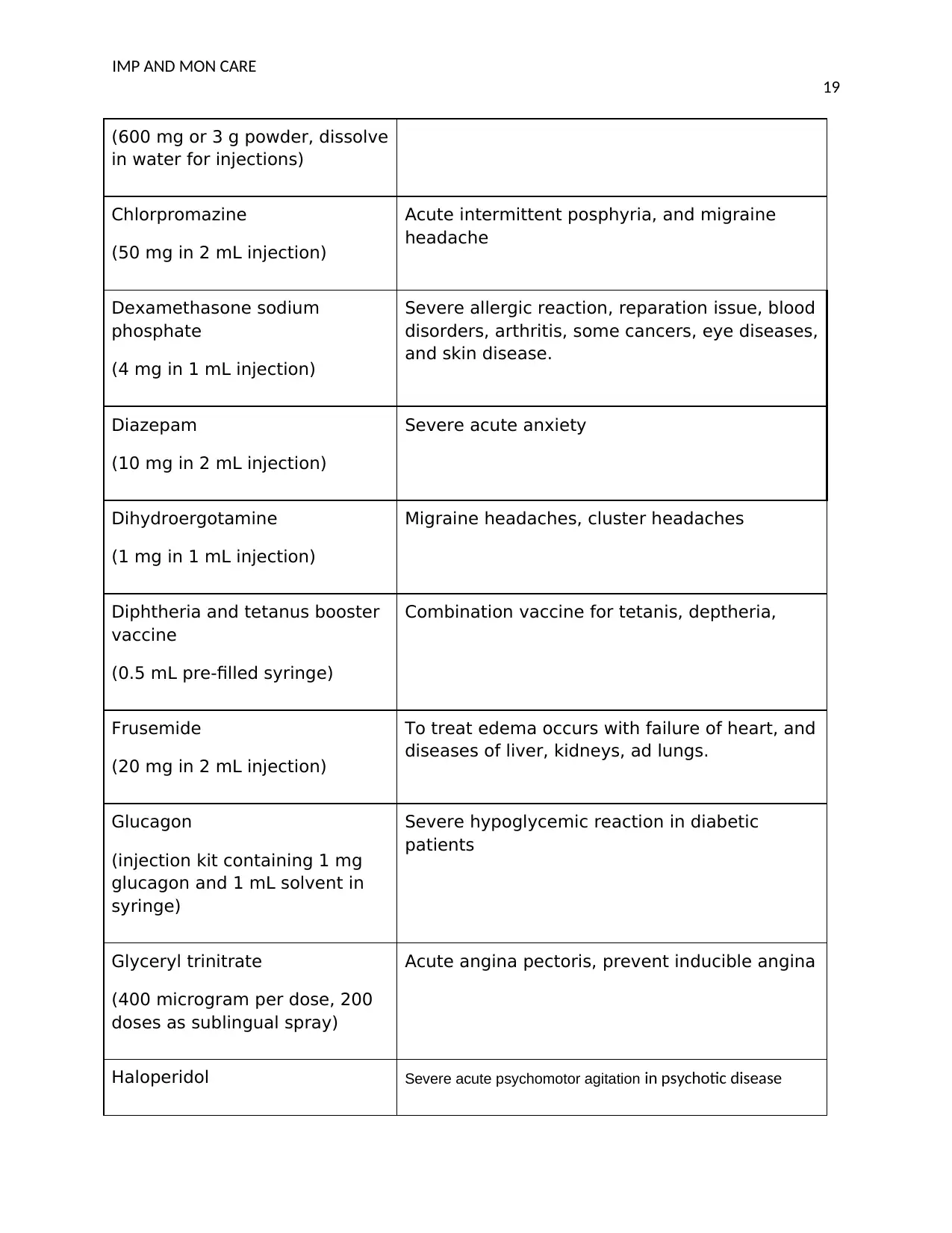
IMP AND MON CARE
19
(600 mg or 3 g powder, dissolve
in water for injections)
Chlorpromazine
(50 mg in 2 mL injection)
Acute intermittent posphyria, and migraine
headache
Dexamethasone sodium
phosphate
(4 mg in 1 mL injection)
Severe allergic reaction, reparation issue, blood
disorders, arthritis, some cancers, eye diseases,
and skin disease.
Diazepam
(10 mg in 2 mL injection)
Severe acute anxiety
Dihydroergotamine
(1 mg in 1 mL injection)
Migraine headaches, cluster headaches
Diphtheria and tetanus booster
vaccine
(0.5 mL pre-filled syringe)
Combination vaccine for tetanis, deptheria,
Frusemide
(20 mg in 2 mL injection)
To treat edema occurs with failure of heart, and
diseases of liver, kidneys, ad lungs.
Glucagon
(injection kit containing 1 mg
glucagon and 1 mL solvent in
syringe)
Severe hypoglycemic reaction in diabetic
patients
Glyceryl trinitrate
(400 microgram per dose, 200
doses as sublingual spray)
Acute angina pectoris, prevent inducible angina
Haloperidol Severe acute psychomotor agitation in psychotic disease
19
(600 mg or 3 g powder, dissolve
in water for injections)
Chlorpromazine
(50 mg in 2 mL injection)
Acute intermittent posphyria, and migraine
headache
Dexamethasone sodium
phosphate
(4 mg in 1 mL injection)
Severe allergic reaction, reparation issue, blood
disorders, arthritis, some cancers, eye diseases,
and skin disease.
Diazepam
(10 mg in 2 mL injection)
Severe acute anxiety
Dihydroergotamine
(1 mg in 1 mL injection)
Migraine headaches, cluster headaches
Diphtheria and tetanus booster
vaccine
(0.5 mL pre-filled syringe)
Combination vaccine for tetanis, deptheria,
Frusemide
(20 mg in 2 mL injection)
To treat edema occurs with failure of heart, and
diseases of liver, kidneys, ad lungs.
Glucagon
(injection kit containing 1 mg
glucagon and 1 mL solvent in
syringe)
Severe hypoglycemic reaction in diabetic
patients
Glyceryl trinitrate
(400 microgram per dose, 200
doses as sublingual spray)
Acute angina pectoris, prevent inducible angina
Haloperidol Severe acute psychomotor agitation in psychotic disease
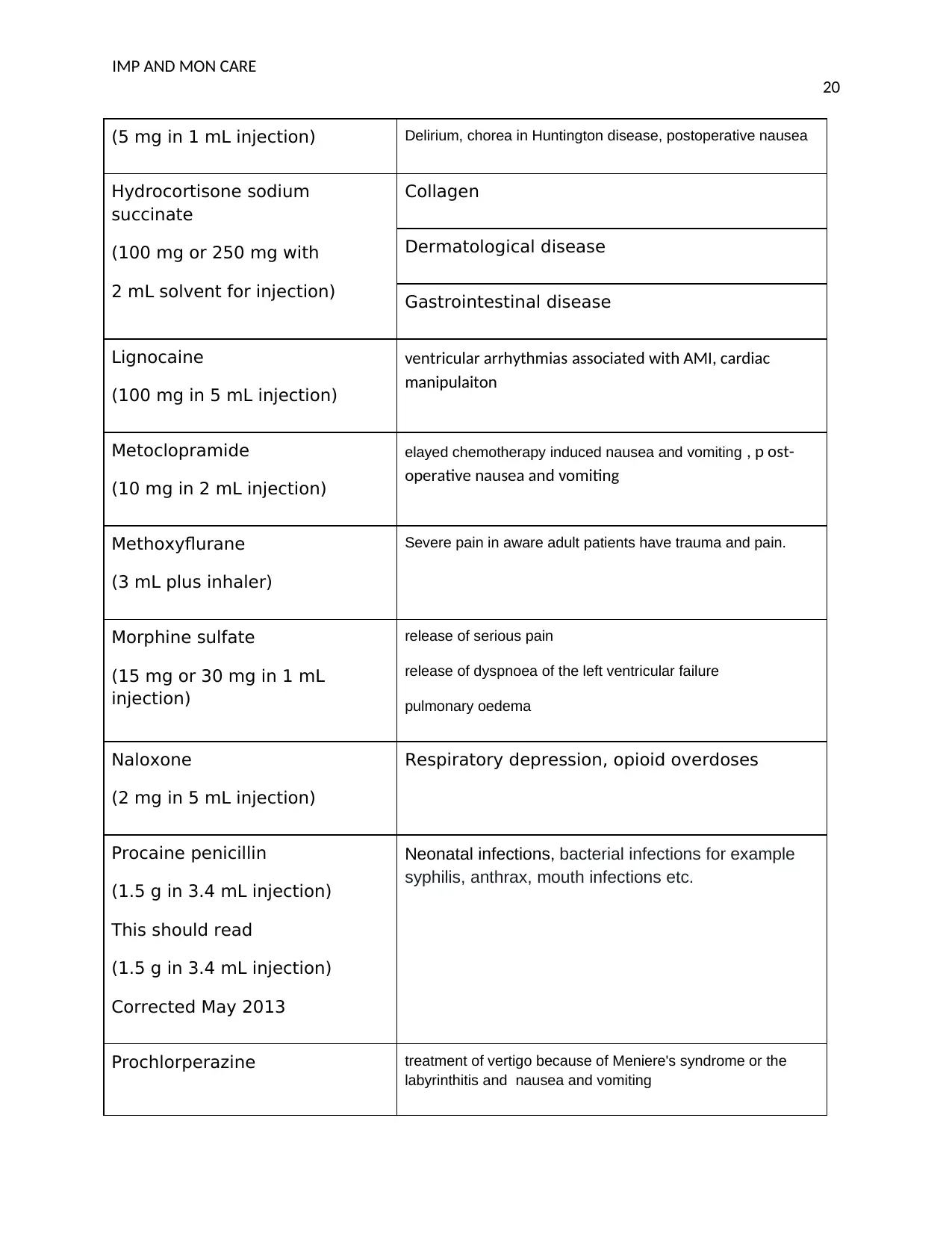
IMP AND MON CARE
20
(5 mg in 1 mL injection) Delirium, chorea in Huntington disease, postoperative nausea
Hydrocortisone sodium
succinate
(100 mg or 250 mg with
2 mL solvent for injection)
Collagen
Dermatological disease
Gastrointestinal disease
Lignocaine
(100 mg in 5 mL injection)
ventricular arrhythmias associated with AMI, cardiac
manipulaiton
Metoclopramide
(10 mg in 2 mL injection)
elayed chemotherapy induced nausea and vomiting , p ost-
operative nausea and vomiting
Methoxyflurane
(3 mL plus inhaler)
Severe pain in aware adult patients have trauma and pain.
Morphine sulfate
(15 mg or 30 mg in 1 mL
injection)
release of serious pain
release of dyspnoea of the left ventricular failure
pulmonary oedema
Naloxone
(2 mg in 5 mL injection)
Respiratory depression, opioid overdoses
Procaine penicillin
(1.5 g in 3.4 mL injection)
This should read
(1.5 g in 3.4 mL injection)
Corrected May 2013
Neonatal infections, bacterial infections for example
syphilis, anthrax, mouth infections etc.
Prochlorperazine treatment of vertigo because of Meniere's syndrome or the
labyrinthitis and nausea and vomiting
20
(5 mg in 1 mL injection) Delirium, chorea in Huntington disease, postoperative nausea
Hydrocortisone sodium
succinate
(100 mg or 250 mg with
2 mL solvent for injection)
Collagen
Dermatological disease
Gastrointestinal disease
Lignocaine
(100 mg in 5 mL injection)
ventricular arrhythmias associated with AMI, cardiac
manipulaiton
Metoclopramide
(10 mg in 2 mL injection)
elayed chemotherapy induced nausea and vomiting , p ost-
operative nausea and vomiting
Methoxyflurane
(3 mL plus inhaler)
Severe pain in aware adult patients have trauma and pain.
Morphine sulfate
(15 mg or 30 mg in 1 mL
injection)
release of serious pain
release of dyspnoea of the left ventricular failure
pulmonary oedema
Naloxone
(2 mg in 5 mL injection)
Respiratory depression, opioid overdoses
Procaine penicillin
(1.5 g in 3.4 mL injection)
This should read
(1.5 g in 3.4 mL injection)
Corrected May 2013
Neonatal infections, bacterial infections for example
syphilis, anthrax, mouth infections etc.
Prochlorperazine treatment of vertigo because of Meniere's syndrome or the
labyrinthitis and nausea and vomiting
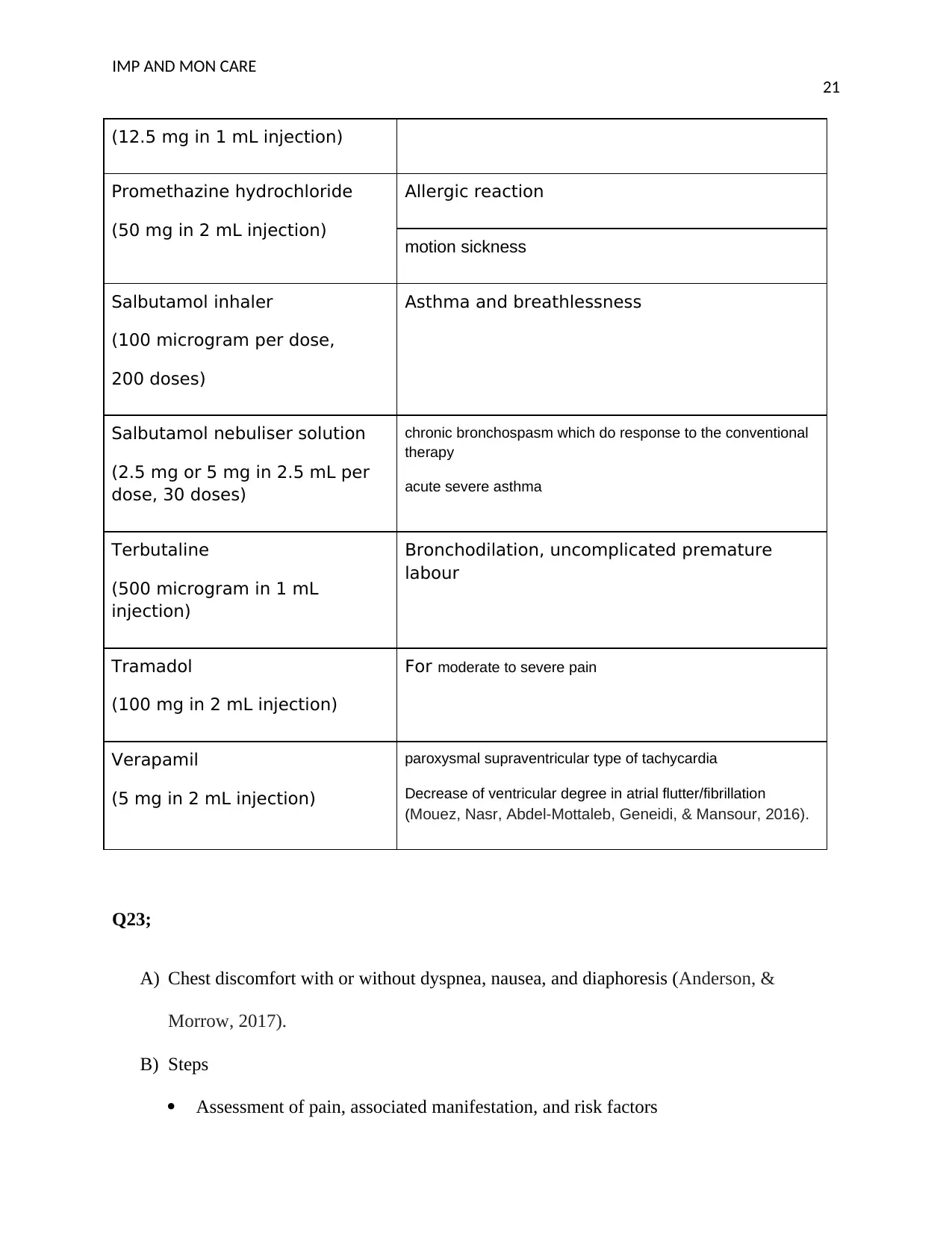
IMP AND MON CARE
21
(12.5 mg in 1 mL injection)
Promethazine hydrochloride
(50 mg in 2 mL injection)
Allergic reaction
motion sickness
Salbutamol inhaler
(100 microgram per dose,
200 doses)
Asthma and breathlessness
Salbutamol nebuliser solution
(2.5 mg or 5 mg in 2.5 mL per
dose, 30 doses)
chronic bronchospasm which do response to the conventional
therapy
acute severe asthma
Terbutaline
(500 microgram in 1 mL
injection)
Bronchodilation, uncomplicated premature
labour
Tramadol
(100 mg in 2 mL injection)
For moderate to severe pain
Verapamil
(5 mg in 2 mL injection)
paroxysmal supraventricular type of tachycardia
Decrease of ventricular degree in atrial flutter/fibrillation
(Mouez, Nasr, Abdel-Mottaleb, Geneidi, & Mansour, 2016).
Q23;
A) Chest discomfort with or without dyspnea, nausea, and diaphoresis (Anderson, &
Morrow, 2017).
B) Steps
Assessment of pain, associated manifestation, and risk factors
21
(12.5 mg in 1 mL injection)
Promethazine hydrochloride
(50 mg in 2 mL injection)
Allergic reaction
motion sickness
Salbutamol inhaler
(100 microgram per dose,
200 doses)
Asthma and breathlessness
Salbutamol nebuliser solution
(2.5 mg or 5 mg in 2.5 mL per
dose, 30 doses)
chronic bronchospasm which do response to the conventional
therapy
acute severe asthma
Terbutaline
(500 microgram in 1 mL
injection)
Bronchodilation, uncomplicated premature
labour
Tramadol
(100 mg in 2 mL injection)
For moderate to severe pain
Verapamil
(5 mg in 2 mL injection)
paroxysmal supraventricular type of tachycardia
Decrease of ventricular degree in atrial flutter/fibrillation
(Mouez, Nasr, Abdel-Mottaleb, Geneidi, & Mansour, 2016).
Q23;
A) Chest discomfort with or without dyspnea, nausea, and diaphoresis (Anderson, &
Morrow, 2017).
B) Steps
Assessment of pain, associated manifestation, and risk factors
Secure Best Marks with AI Grader
Need help grading? Try our AI Grader for instant feedback on your assignments.
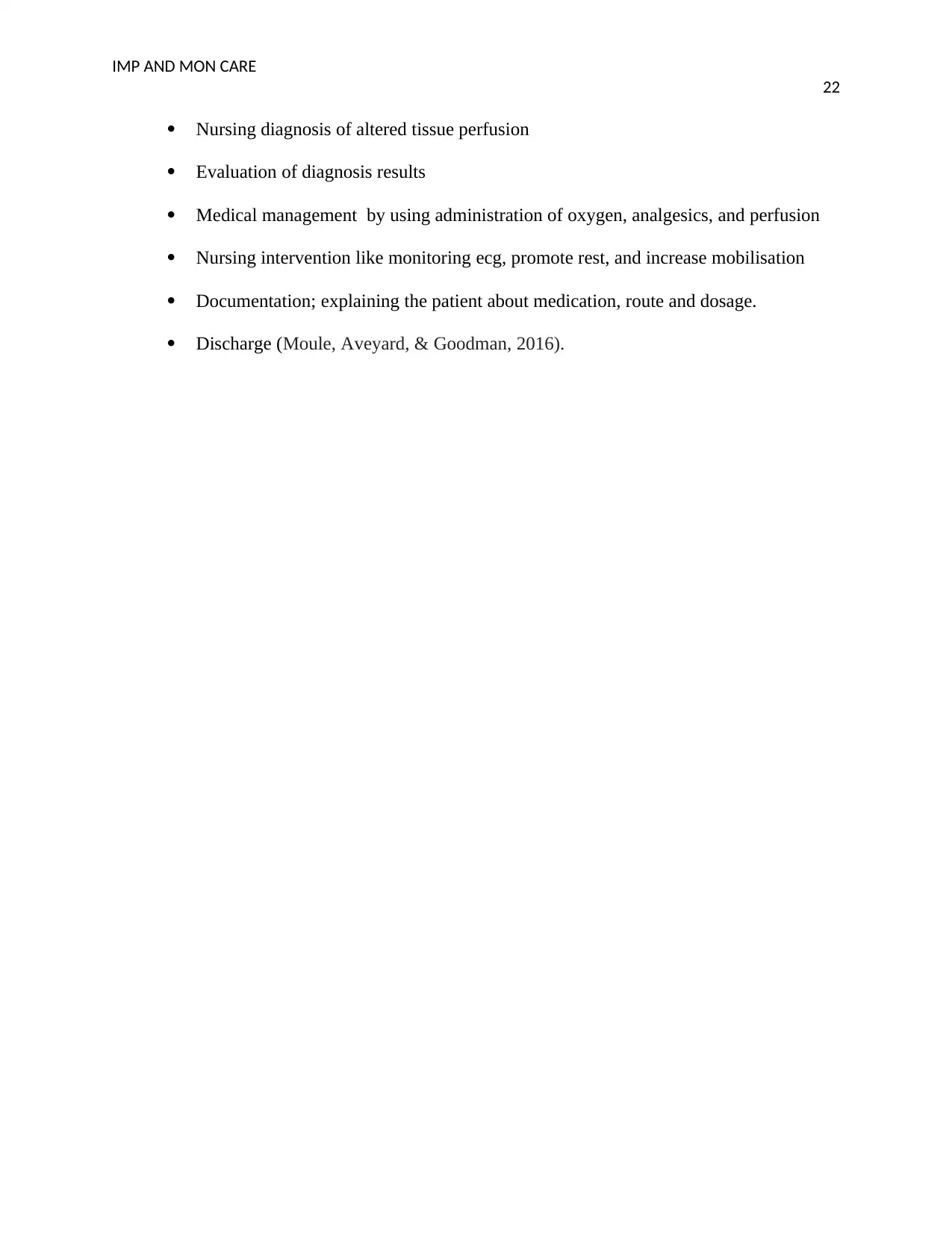
IMP AND MON CARE
22
Nursing diagnosis of altered tissue perfusion
Evaluation of diagnosis results
Medical management by using administration of oxygen, analgesics, and perfusion
Nursing intervention like monitoring ecg, promote rest, and increase mobilisation
Documentation; explaining the patient about medication, route and dosage.
Discharge (Moule, Aveyard, & Goodman, 2016).
22
Nursing diagnosis of altered tissue perfusion
Evaluation of diagnosis results
Medical management by using administration of oxygen, analgesics, and perfusion
Nursing intervention like monitoring ecg, promote rest, and increase mobilisation
Documentation; explaining the patient about medication, route and dosage.
Discharge (Moule, Aveyard, & Goodman, 2016).
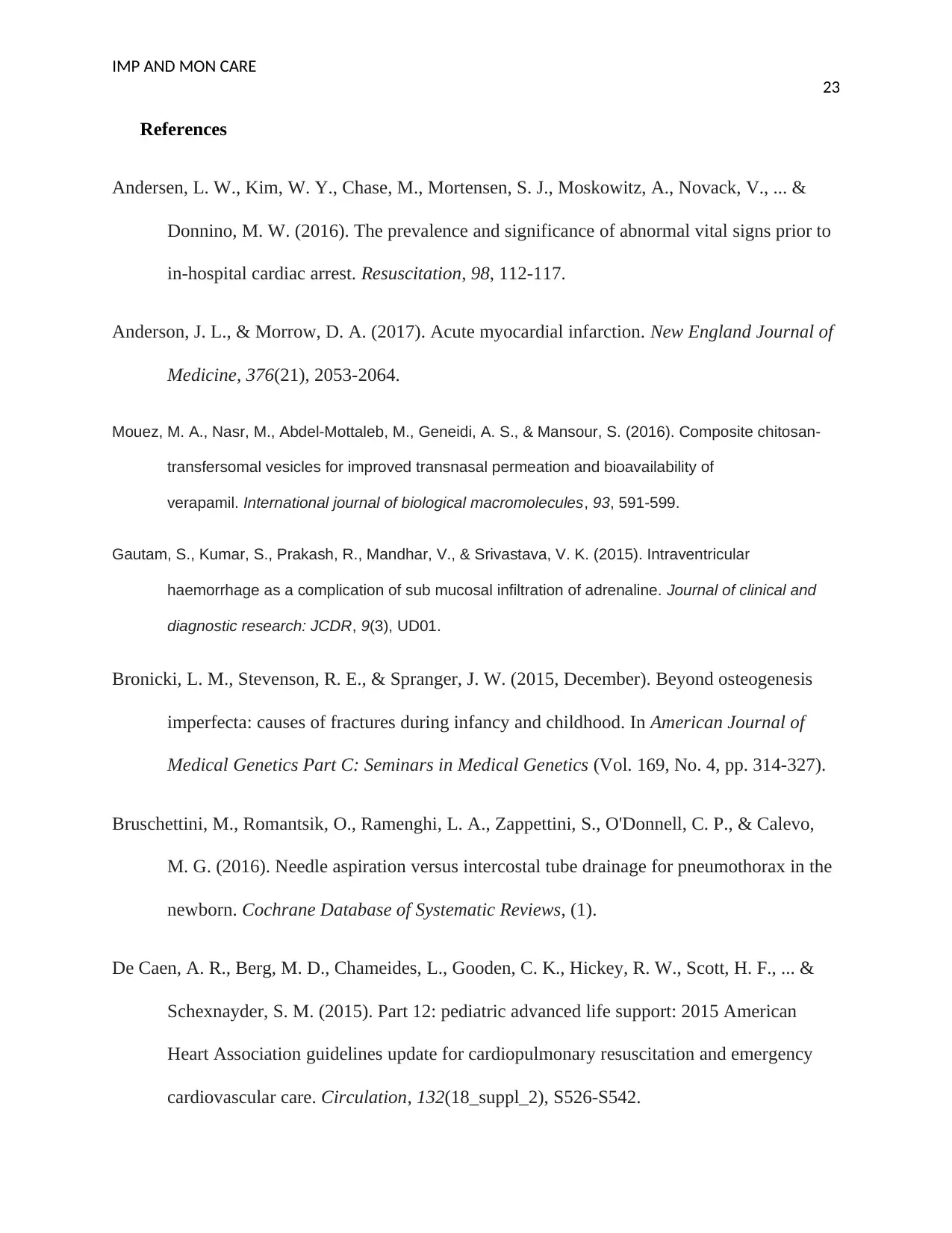
IMP AND MON CARE
23
References
Andersen, L. W., Kim, W. Y., Chase, M., Mortensen, S. J., Moskowitz, A., Novack, V., ... &
Donnino, M. W. (2016). The prevalence and significance of abnormal vital signs prior to
in-hospital cardiac arrest. Resuscitation, 98, 112-117.
Anderson, J. L., & Morrow, D. A. (2017). Acute myocardial infarction. New England Journal of
Medicine, 376(21), 2053-2064.
Mouez, M. A., Nasr, M., Abdel-Mottaleb, M., Geneidi, A. S., & Mansour, S. (2016). Composite chitosan-
transfersomal vesicles for improved transnasal permeation and bioavailability of
verapamil. International journal of biological macromolecules, 93, 591-599.
Gautam, S., Kumar, S., Prakash, R., Mandhar, V., & Srivastava, V. K. (2015). Intraventricular
haemorrhage as a complication of sub mucosal infiltration of adrenaline. Journal of clinical and
diagnostic research: JCDR, 9(3), UD01.
Bronicki, L. M., Stevenson, R. E., & Spranger, J. W. (2015, December). Beyond osteogenesis
imperfecta: causes of fractures during infancy and childhood. In American Journal of
Medical Genetics Part C: Seminars in Medical Genetics (Vol. 169, No. 4, pp. 314-327).
Bruschettini, M., Romantsik, O., Ramenghi, L. A., Zappettini, S., O'Donnell, C. P., & Calevo,
M. G. (2016). Needle aspiration versus intercostal tube drainage for pneumothorax in the
newborn. Cochrane Database of Systematic Reviews, (1).
De Caen, A. R., Berg, M. D., Chameides, L., Gooden, C. K., Hickey, R. W., Scott, H. F., ... &
Schexnayder, S. M. (2015). Part 12: pediatric advanced life support: 2015 American
Heart Association guidelines update for cardiopulmonary resuscitation and emergency
cardiovascular care. Circulation, 132(18_suppl_2), S526-S542.
23
References
Andersen, L. W., Kim, W. Y., Chase, M., Mortensen, S. J., Moskowitz, A., Novack, V., ... &
Donnino, M. W. (2016). The prevalence and significance of abnormal vital signs prior to
in-hospital cardiac arrest. Resuscitation, 98, 112-117.
Anderson, J. L., & Morrow, D. A. (2017). Acute myocardial infarction. New England Journal of
Medicine, 376(21), 2053-2064.
Mouez, M. A., Nasr, M., Abdel-Mottaleb, M., Geneidi, A. S., & Mansour, S. (2016). Composite chitosan-
transfersomal vesicles for improved transnasal permeation and bioavailability of
verapamil. International journal of biological macromolecules, 93, 591-599.
Gautam, S., Kumar, S., Prakash, R., Mandhar, V., & Srivastava, V. K. (2015). Intraventricular
haemorrhage as a complication of sub mucosal infiltration of adrenaline. Journal of clinical and
diagnostic research: JCDR, 9(3), UD01.
Bronicki, L. M., Stevenson, R. E., & Spranger, J. W. (2015, December). Beyond osteogenesis
imperfecta: causes of fractures during infancy and childhood. In American Journal of
Medical Genetics Part C: Seminars in Medical Genetics (Vol. 169, No. 4, pp. 314-327).
Bruschettini, M., Romantsik, O., Ramenghi, L. A., Zappettini, S., O'Donnell, C. P., & Calevo,
M. G. (2016). Needle aspiration versus intercostal tube drainage for pneumothorax in the
newborn. Cochrane Database of Systematic Reviews, (1).
De Caen, A. R., Berg, M. D., Chameides, L., Gooden, C. K., Hickey, R. W., Scott, H. F., ... &
Schexnayder, S. M. (2015). Part 12: pediatric advanced life support: 2015 American
Heart Association guidelines update for cardiopulmonary resuscitation and emergency
cardiovascular care. Circulation, 132(18_suppl_2), S526-S542.
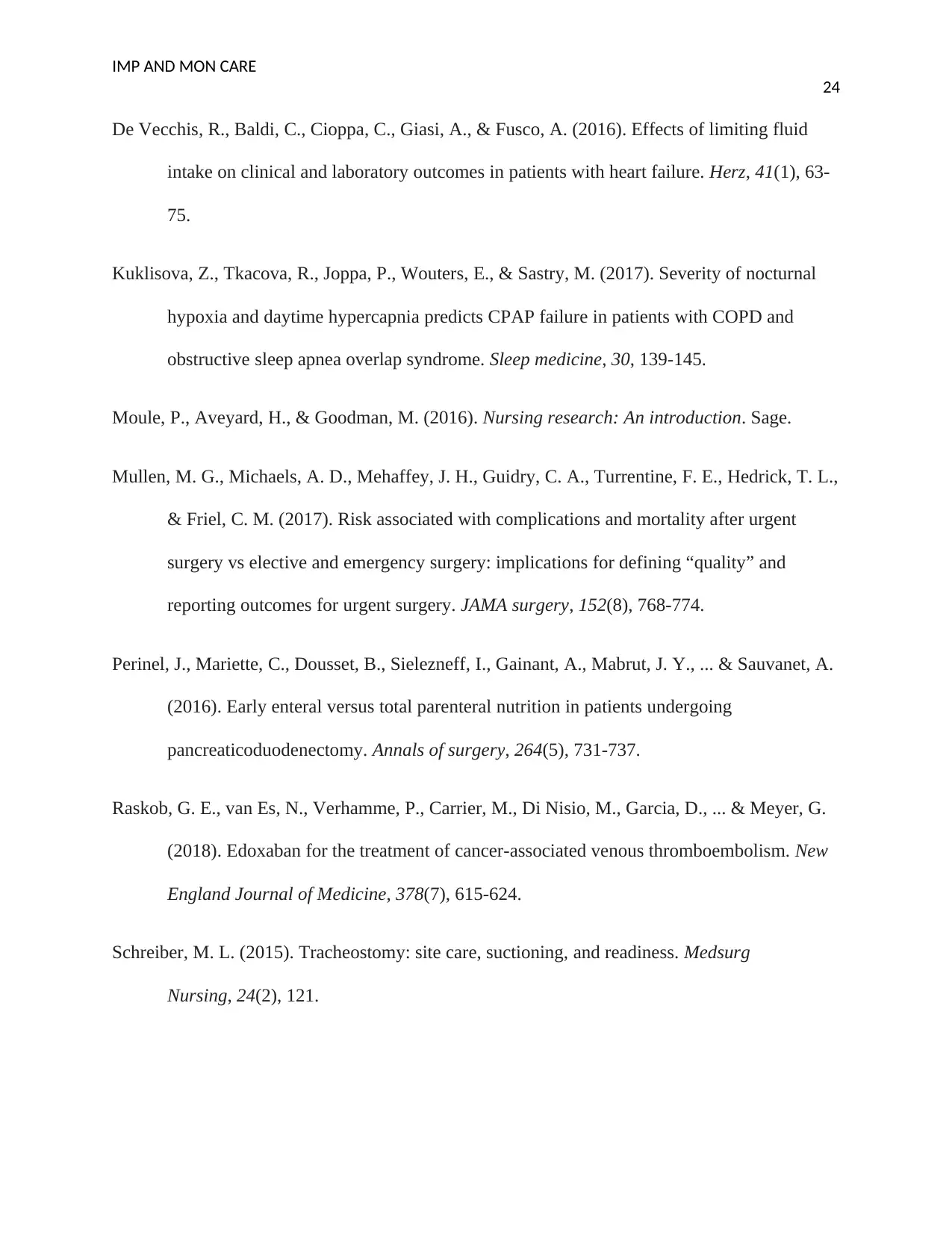
IMP AND MON CARE
24
De Vecchis, R., Baldi, C., Cioppa, C., Giasi, A., & Fusco, A. (2016). Effects of limiting fluid
intake on clinical and laboratory outcomes in patients with heart failure. Herz, 41(1), 63-
75.
Kuklisova, Z., Tkacova, R., Joppa, P., Wouters, E., & Sastry, M. (2017). Severity of nocturnal
hypoxia and daytime hypercapnia predicts CPAP failure in patients with COPD and
obstructive sleep apnea overlap syndrome. Sleep medicine, 30, 139-145.
Moule, P., Aveyard, H., & Goodman, M. (2016). Nursing research: An introduction. Sage.
Mullen, M. G., Michaels, A. D., Mehaffey, J. H., Guidry, C. A., Turrentine, F. E., Hedrick, T. L.,
& Friel, C. M. (2017). Risk associated with complications and mortality after urgent
surgery vs elective and emergency surgery: implications for defining “quality” and
reporting outcomes for urgent surgery. JAMA surgery, 152(8), 768-774.
Perinel, J., Mariette, C., Dousset, B., Sielezneff, I., Gainant, A., Mabrut, J. Y., ... & Sauvanet, A.
(2016). Early enteral versus total parenteral nutrition in patients undergoing
pancreaticoduodenectomy. Annals of surgery, 264(5), 731-737.
Raskob, G. E., van Es, N., Verhamme, P., Carrier, M., Di Nisio, M., Garcia, D., ... & Meyer, G.
(2018). Edoxaban for the treatment of cancer-associated venous thromboembolism. New
England Journal of Medicine, 378(7), 615-624.
Schreiber, M. L. (2015). Tracheostomy: site care, suctioning, and readiness. Medsurg
Nursing, 24(2), 121.
24
De Vecchis, R., Baldi, C., Cioppa, C., Giasi, A., & Fusco, A. (2016). Effects of limiting fluid
intake on clinical and laboratory outcomes in patients with heart failure. Herz, 41(1), 63-
75.
Kuklisova, Z., Tkacova, R., Joppa, P., Wouters, E., & Sastry, M. (2017). Severity of nocturnal
hypoxia and daytime hypercapnia predicts CPAP failure in patients with COPD and
obstructive sleep apnea overlap syndrome. Sleep medicine, 30, 139-145.
Moule, P., Aveyard, H., & Goodman, M. (2016). Nursing research: An introduction. Sage.
Mullen, M. G., Michaels, A. D., Mehaffey, J. H., Guidry, C. A., Turrentine, F. E., Hedrick, T. L.,
& Friel, C. M. (2017). Risk associated with complications and mortality after urgent
surgery vs elective and emergency surgery: implications for defining “quality” and
reporting outcomes for urgent surgery. JAMA surgery, 152(8), 768-774.
Perinel, J., Mariette, C., Dousset, B., Sielezneff, I., Gainant, A., Mabrut, J. Y., ... & Sauvanet, A.
(2016). Early enteral versus total parenteral nutrition in patients undergoing
pancreaticoduodenectomy. Annals of surgery, 264(5), 731-737.
Raskob, G. E., van Es, N., Verhamme, P., Carrier, M., Di Nisio, M., Garcia, D., ... & Meyer, G.
(2018). Edoxaban for the treatment of cancer-associated venous thromboembolism. New
England Journal of Medicine, 378(7), 615-624.
Schreiber, M. L. (2015). Tracheostomy: site care, suctioning, and readiness. Medsurg
Nursing, 24(2), 121.
Paraphrase This Document
Need a fresh take? Get an instant paraphrase of this document with our AI Paraphraser
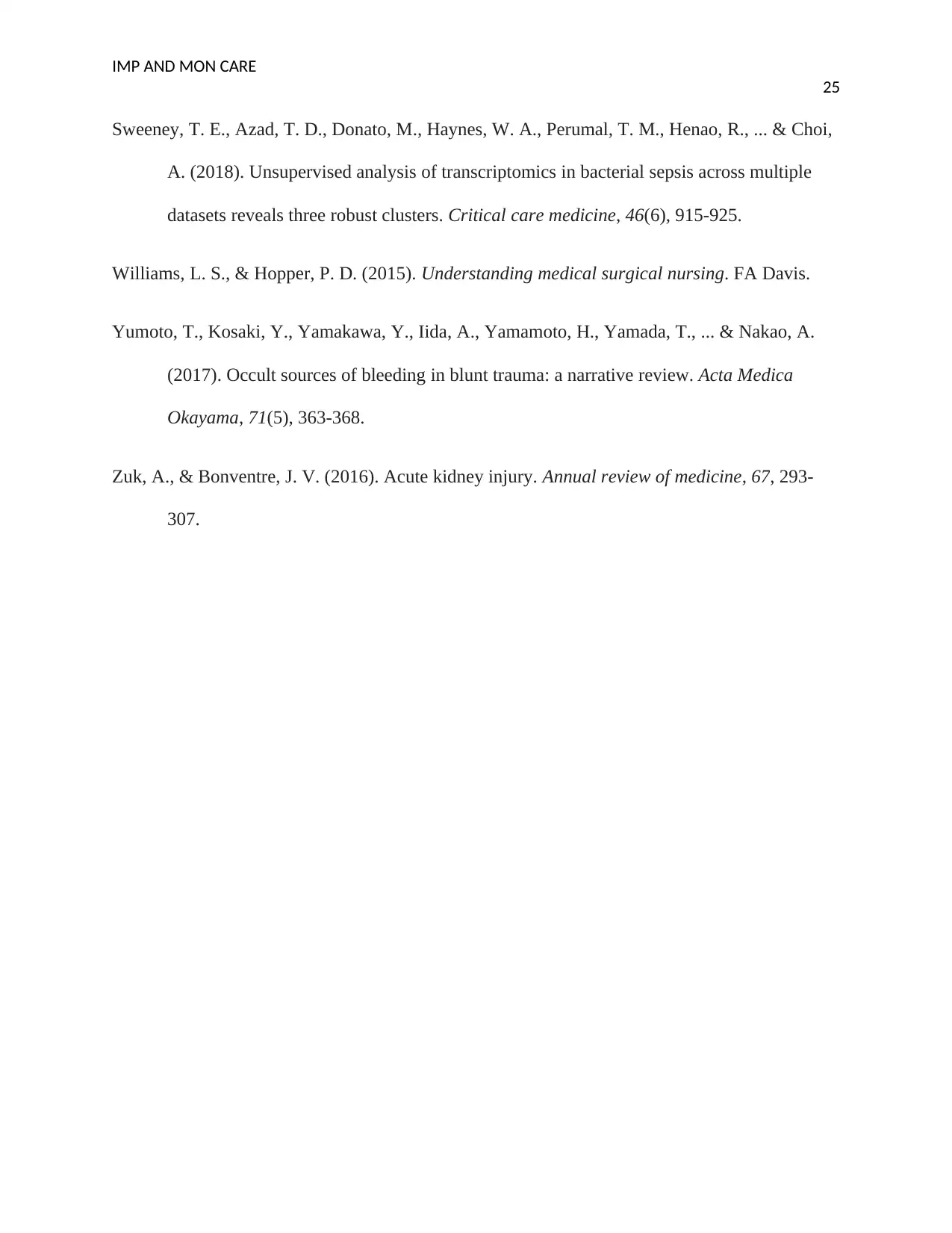
IMP AND MON CARE
25
Sweeney, T. E., Azad, T. D., Donato, M., Haynes, W. A., Perumal, T. M., Henao, R., ... & Choi,
A. (2018). Unsupervised analysis of transcriptomics in bacterial sepsis across multiple
datasets reveals three robust clusters. Critical care medicine, 46(6), 915-925.
Williams, L. S., & Hopper, P. D. (2015). Understanding medical surgical nursing. FA Davis.
Yumoto, T., Kosaki, Y., Yamakawa, Y., Iida, A., Yamamoto, H., Yamada, T., ... & Nakao, A.
(2017). Occult sources of bleeding in blunt trauma: a narrative review. Acta Medica
Okayama, 71(5), 363-368.
Zuk, A., & Bonventre, J. V. (2016). Acute kidney injury. Annual review of medicine, 67, 293-
307.
25
Sweeney, T. E., Azad, T. D., Donato, M., Haynes, W. A., Perumal, T. M., Henao, R., ... & Choi,
A. (2018). Unsupervised analysis of transcriptomics in bacterial sepsis across multiple
datasets reveals three robust clusters. Critical care medicine, 46(6), 915-925.
Williams, L. S., & Hopper, P. D. (2015). Understanding medical surgical nursing. FA Davis.
Yumoto, T., Kosaki, Y., Yamakawa, Y., Iida, A., Yamamoto, H., Yamada, T., ... & Nakao, A.
(2017). Occult sources of bleeding in blunt trauma: a narrative review. Acta Medica
Okayama, 71(5), 363-368.
Zuk, A., & Bonventre, J. V. (2016). Acute kidney injury. Annual review of medicine, 67, 293-
307.
1 out of 26
Related Documents
Your All-in-One AI-Powered Toolkit for Academic Success.
+13062052269
info@desklib.com
Available 24*7 on WhatsApp / Email
![[object Object]](/_next/static/media/star-bottom.7253800d.svg)
Unlock your academic potential
© 2024 | Zucol Services PVT LTD | All rights reserved.





